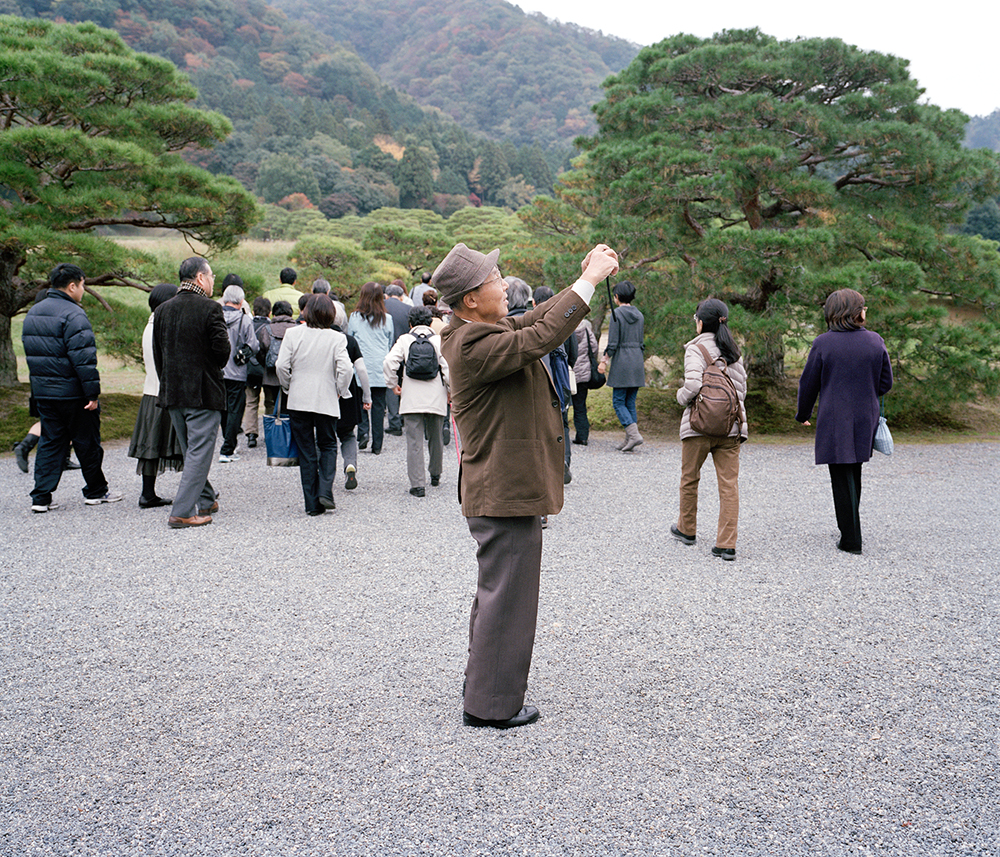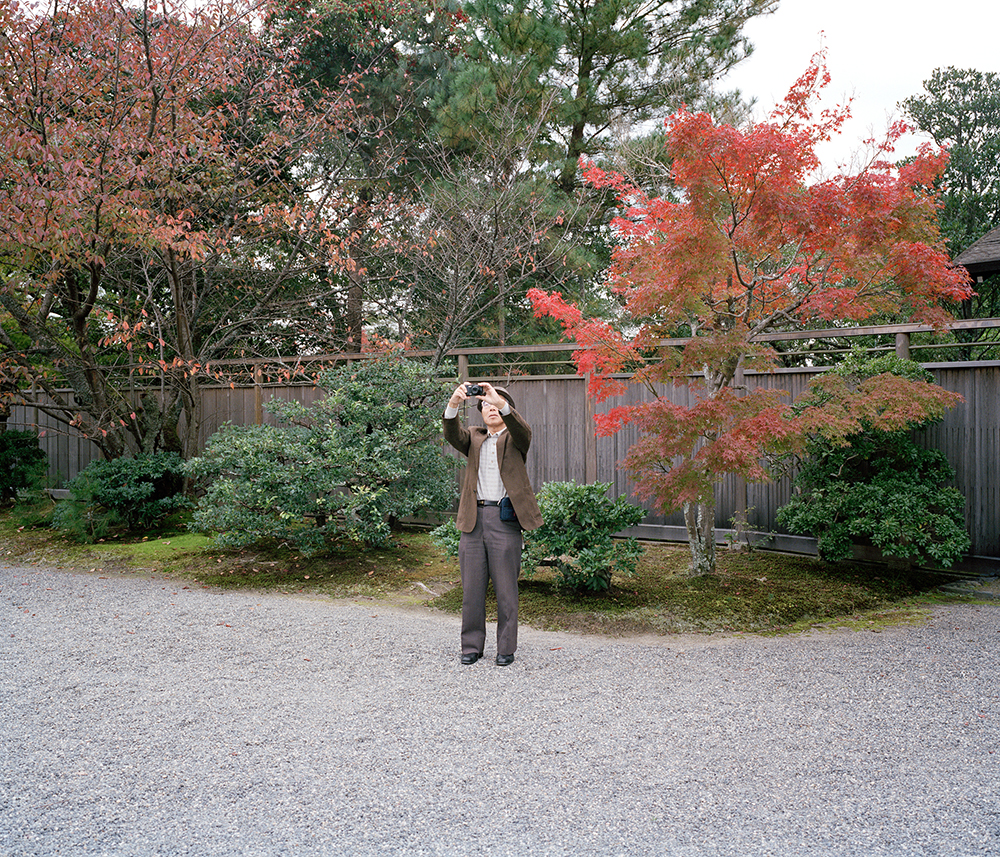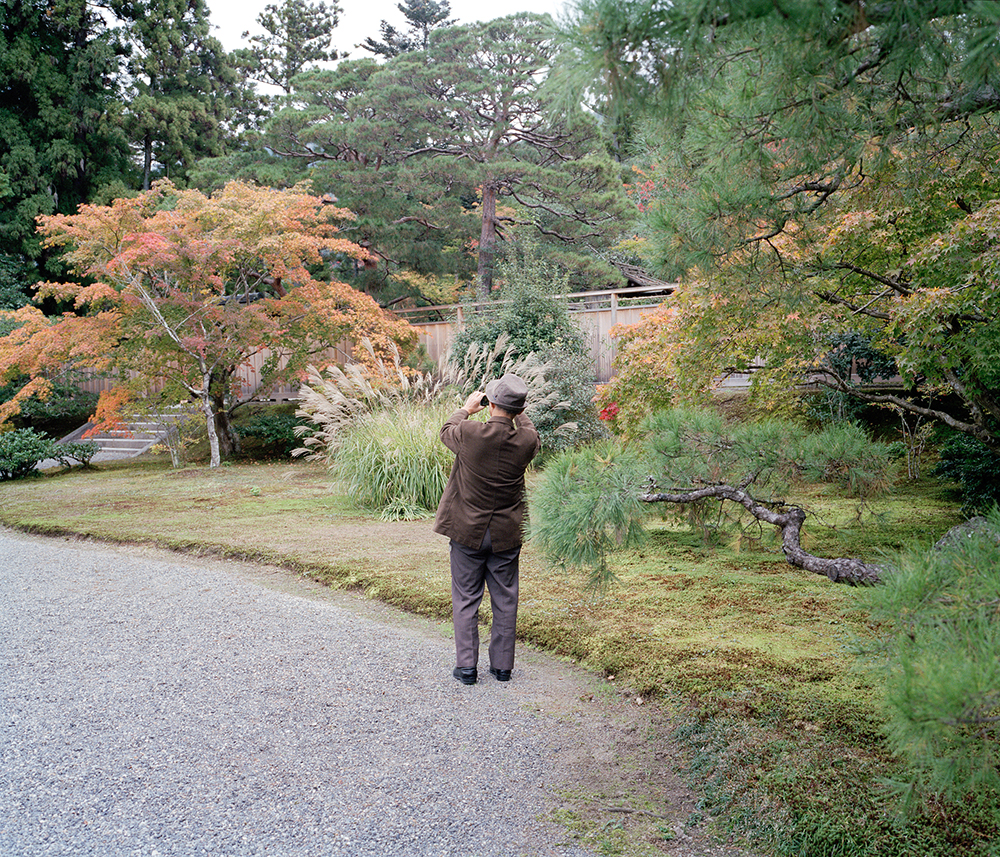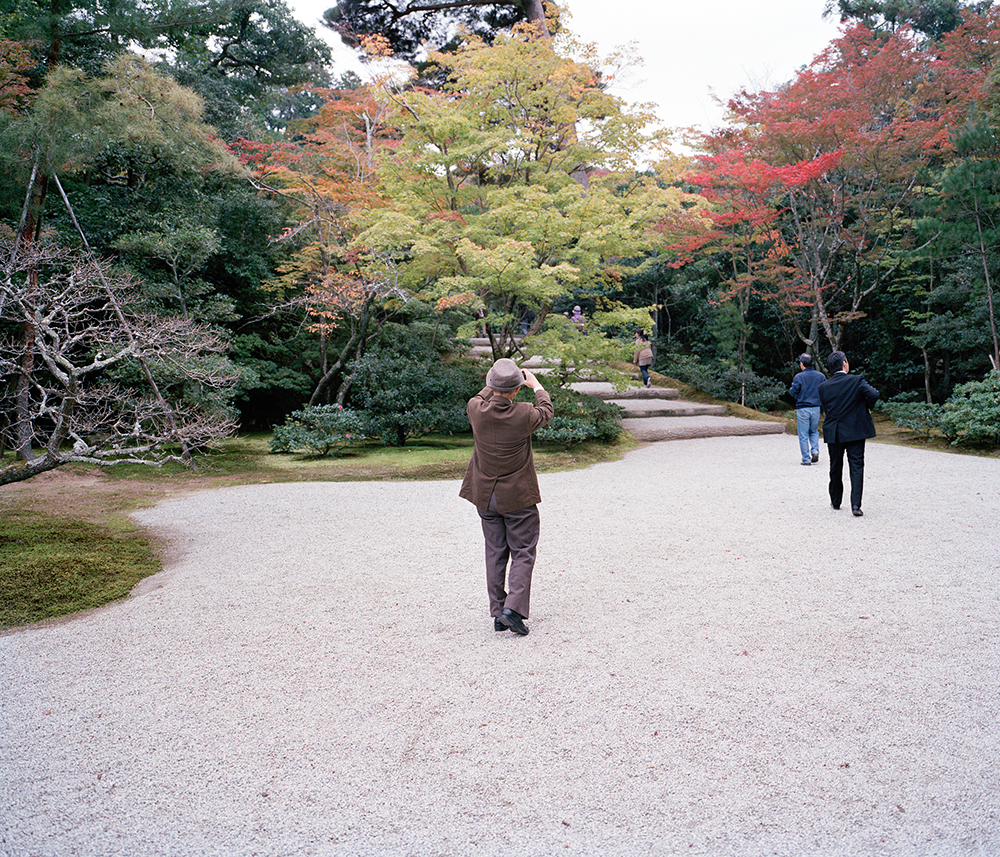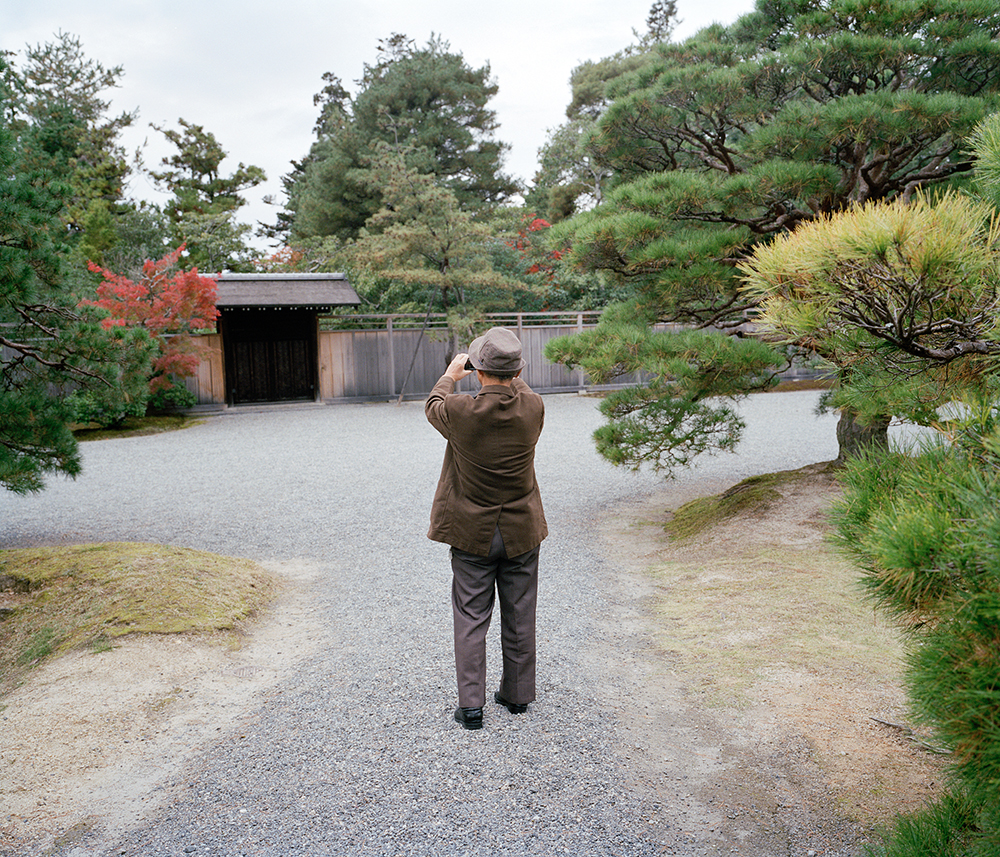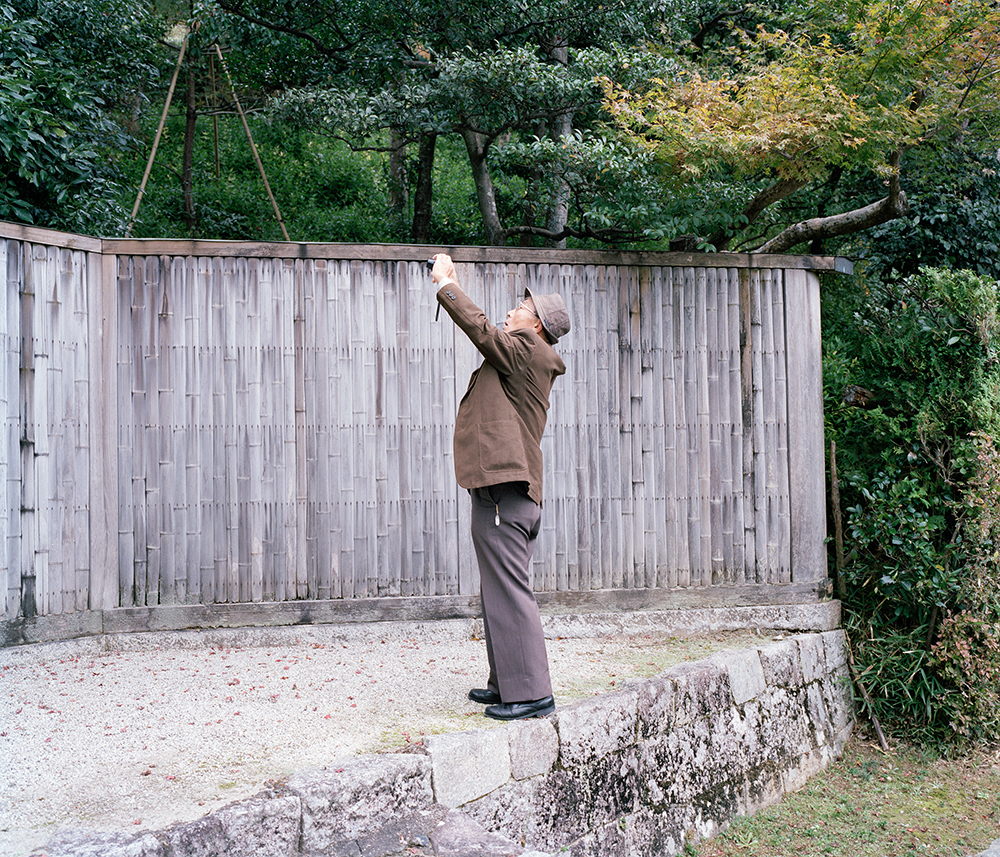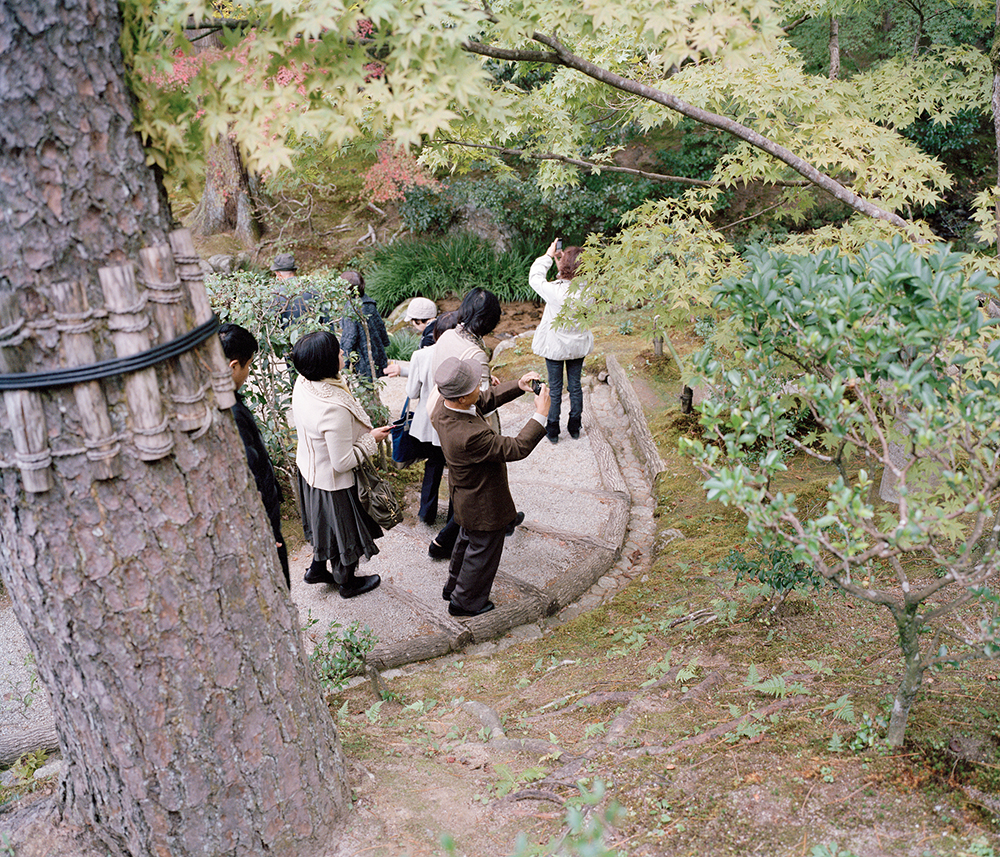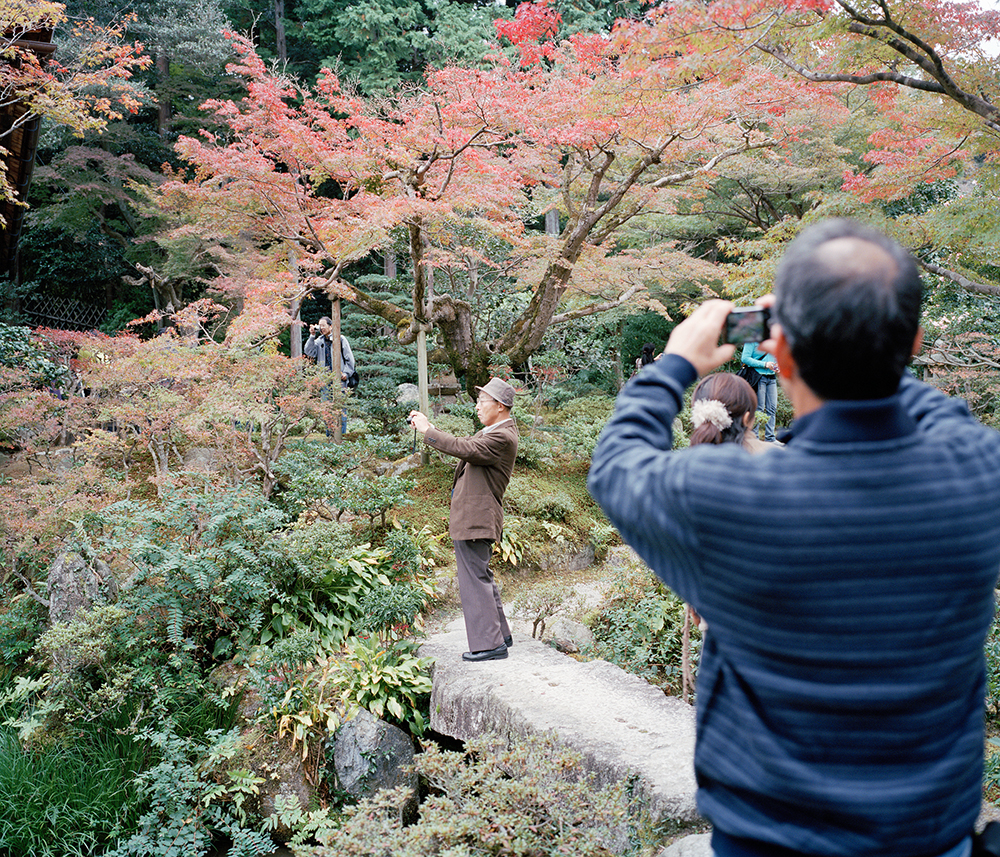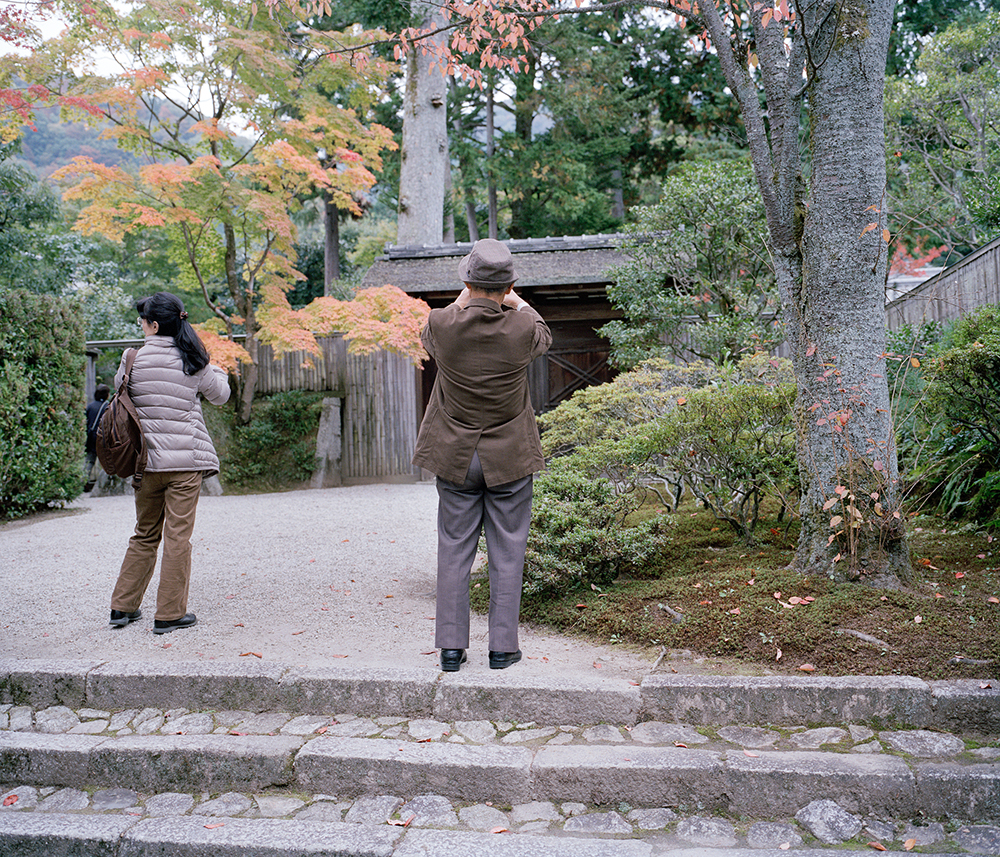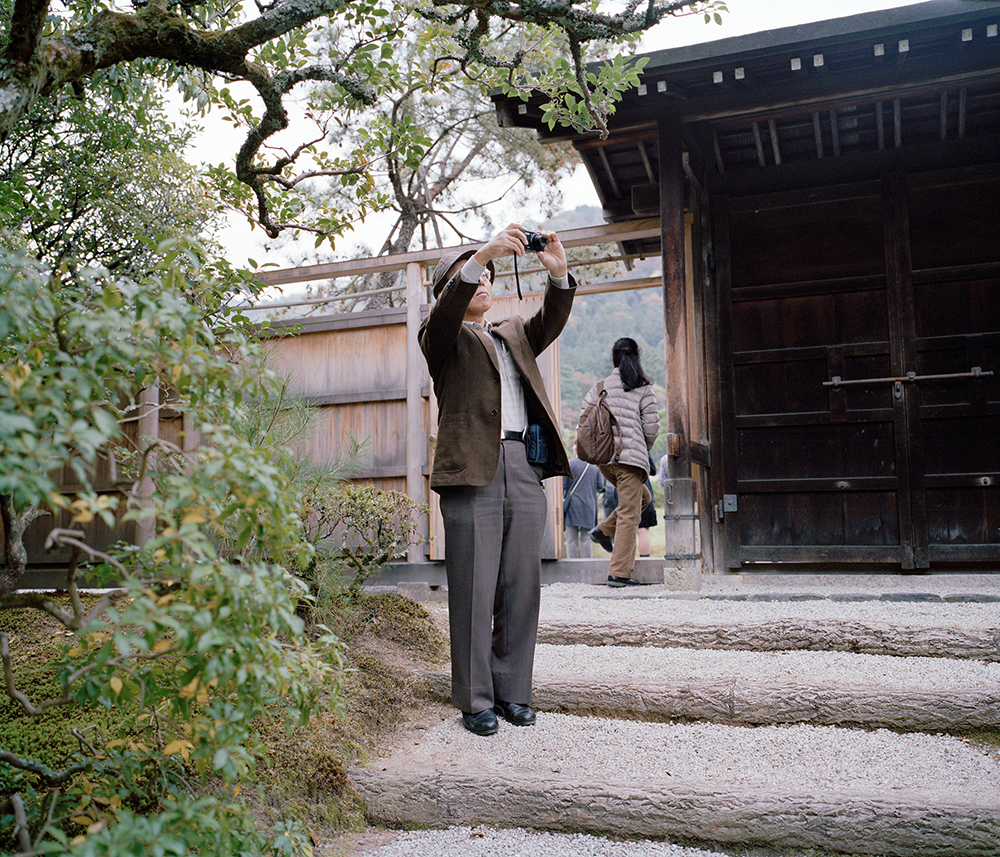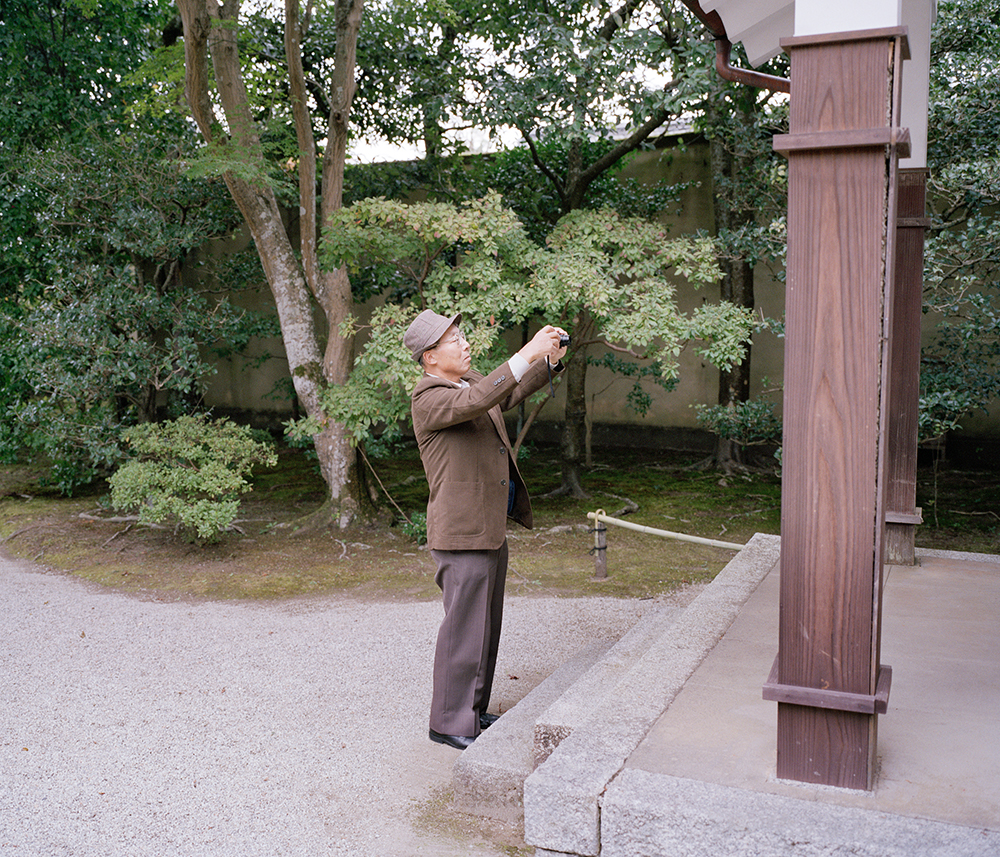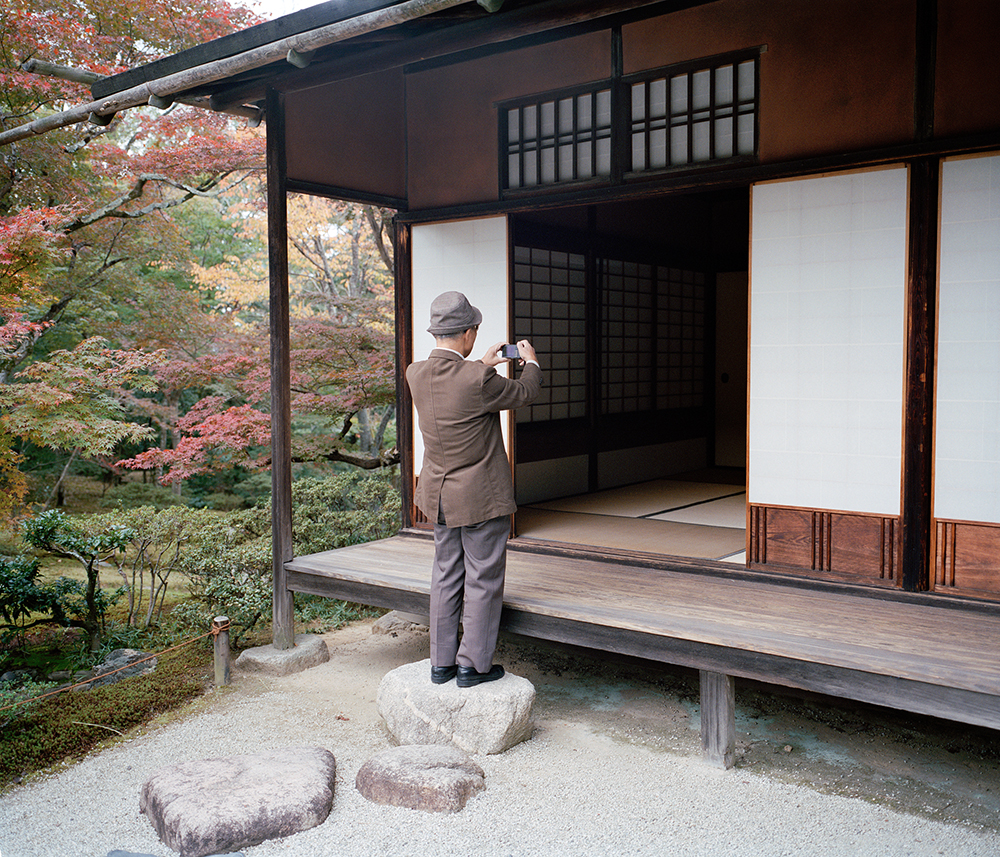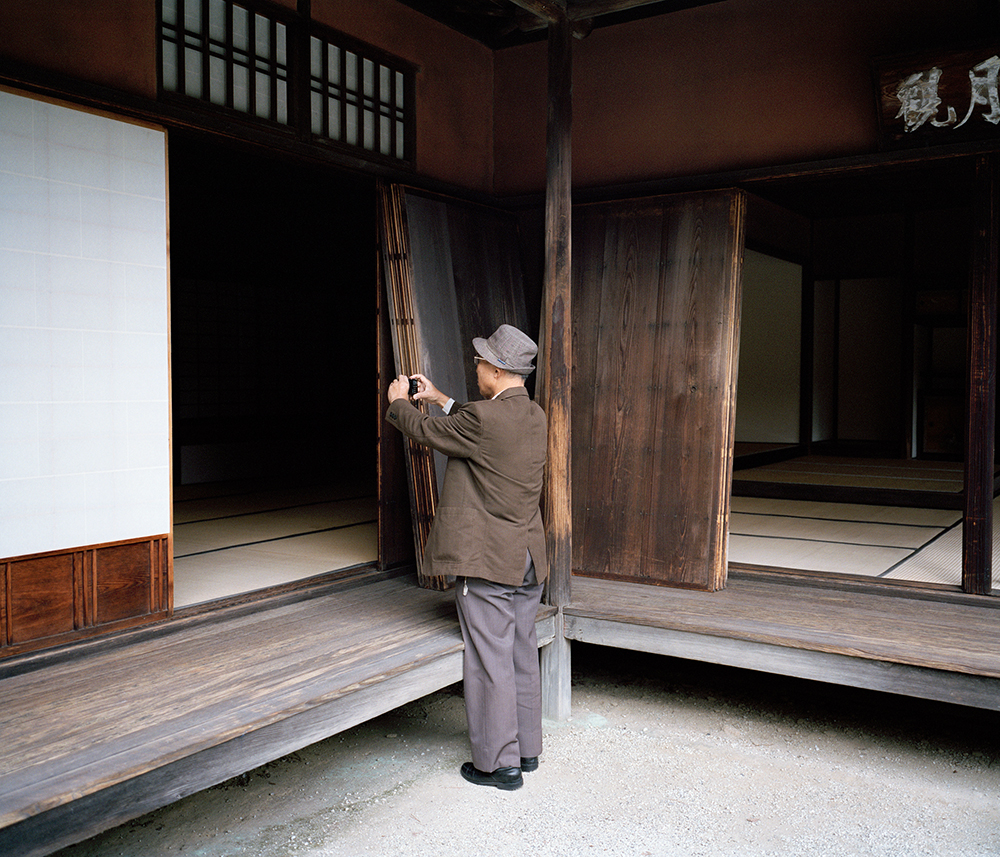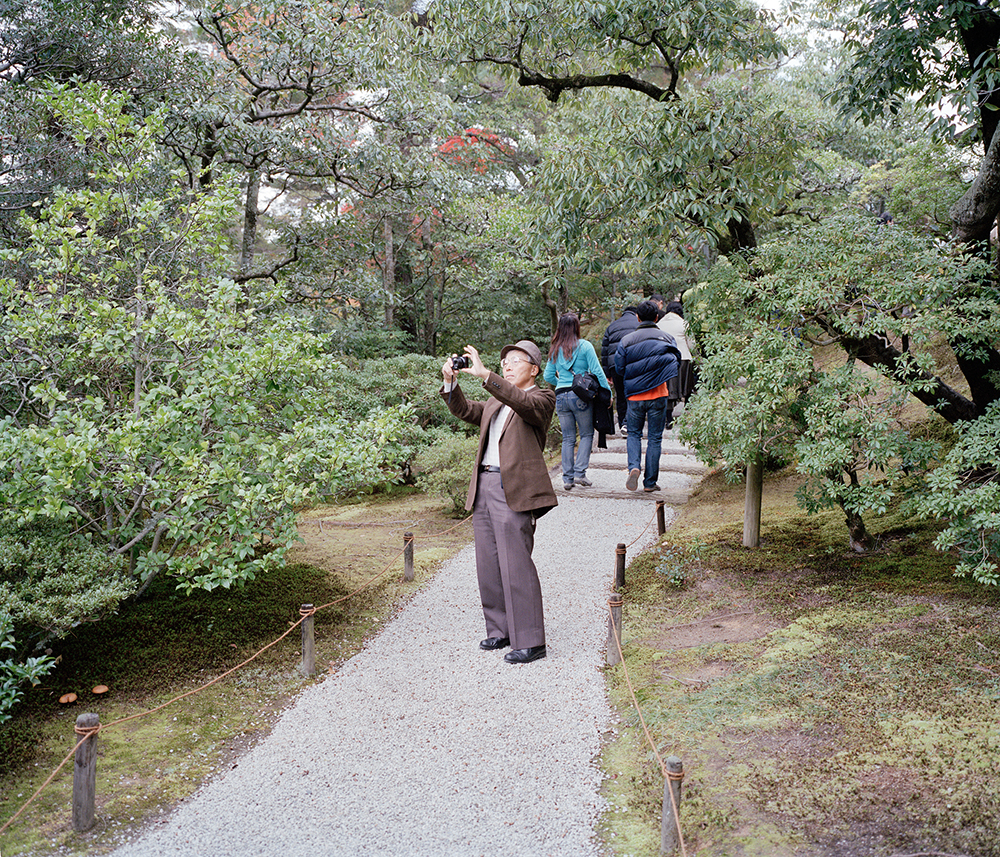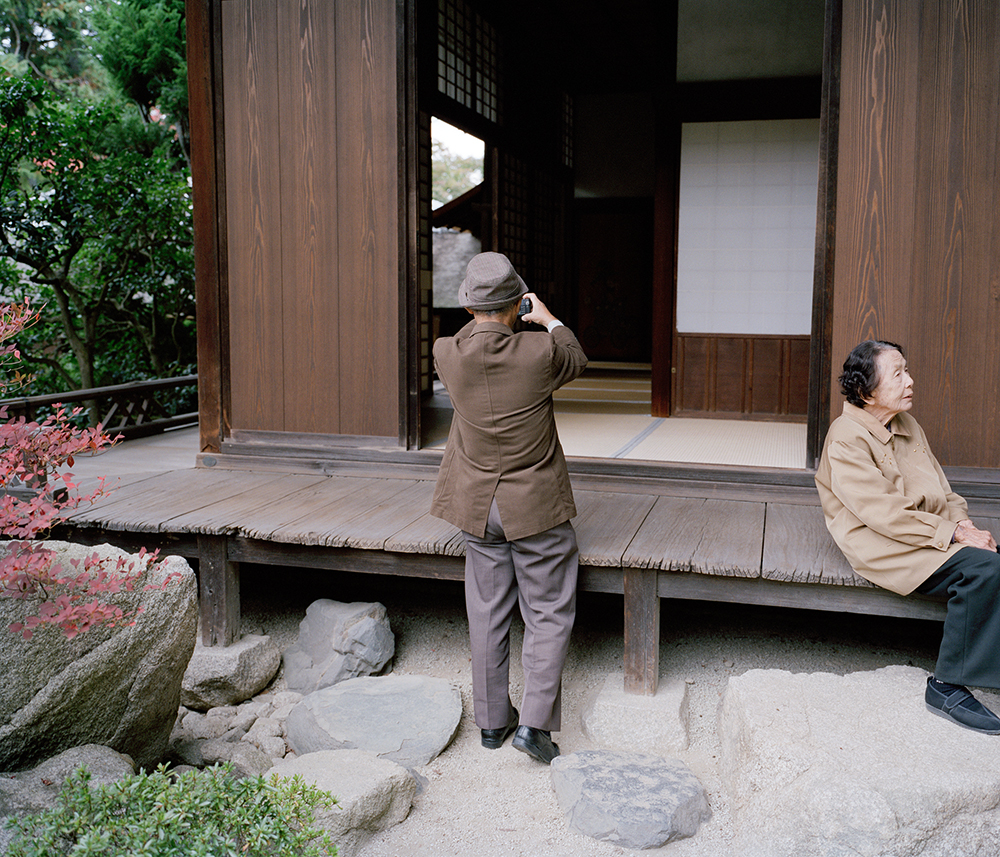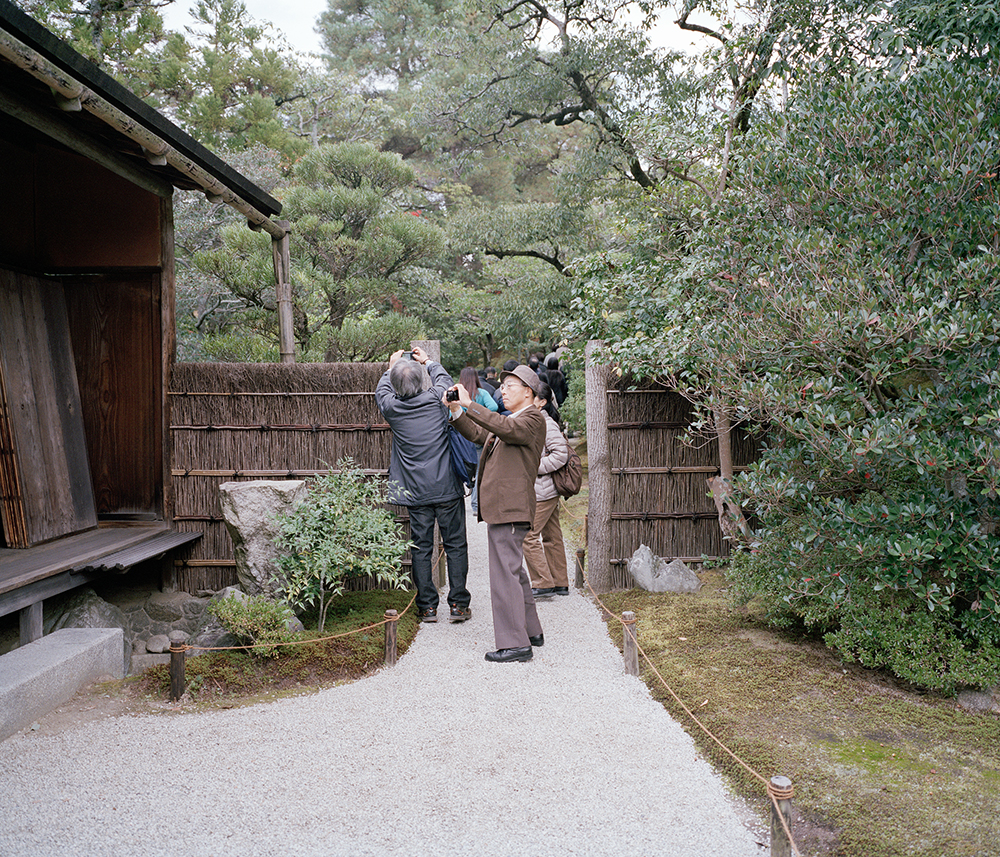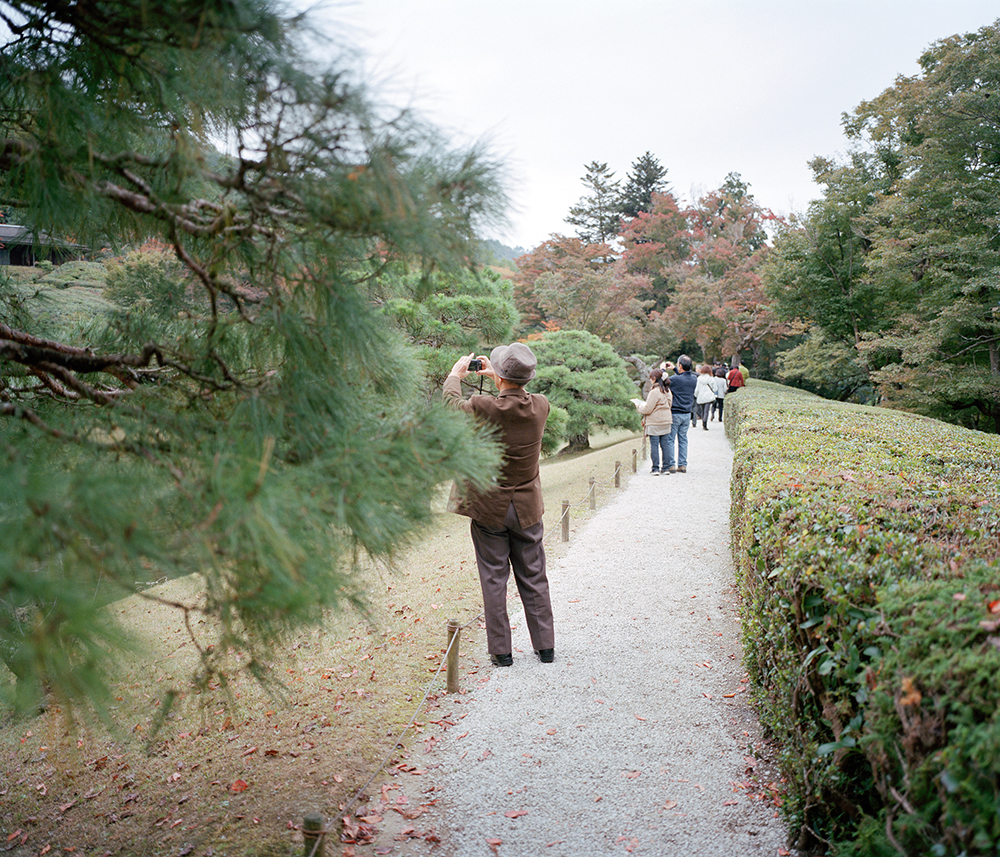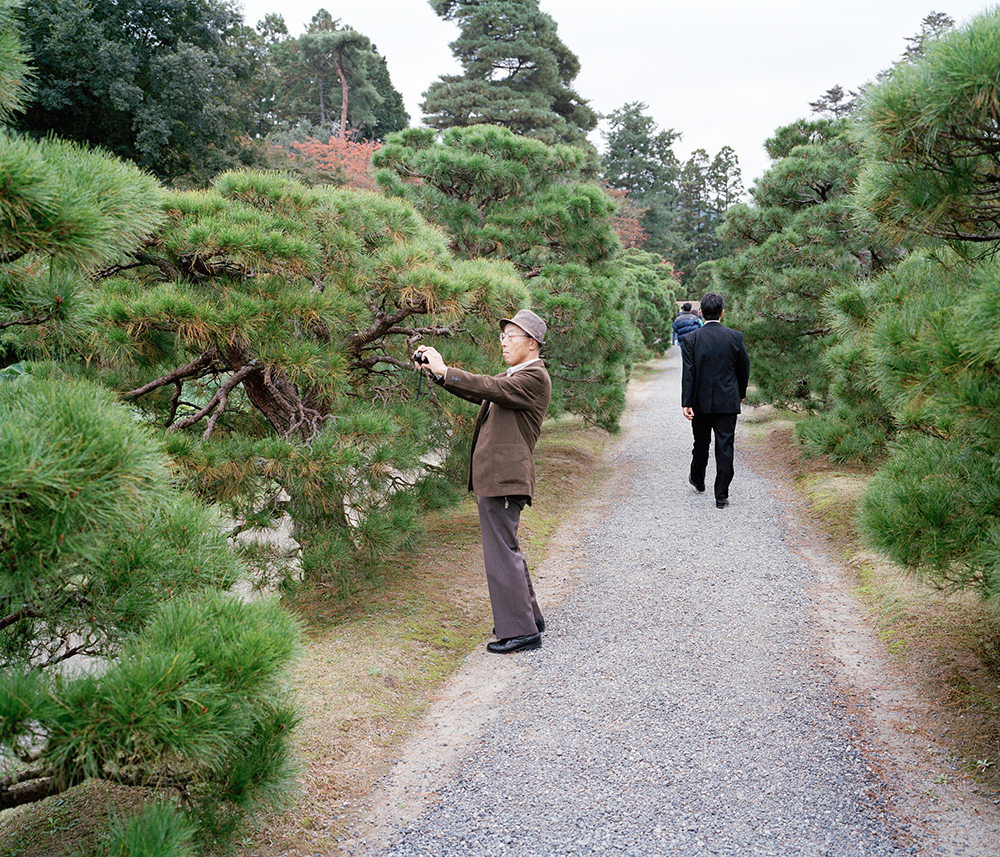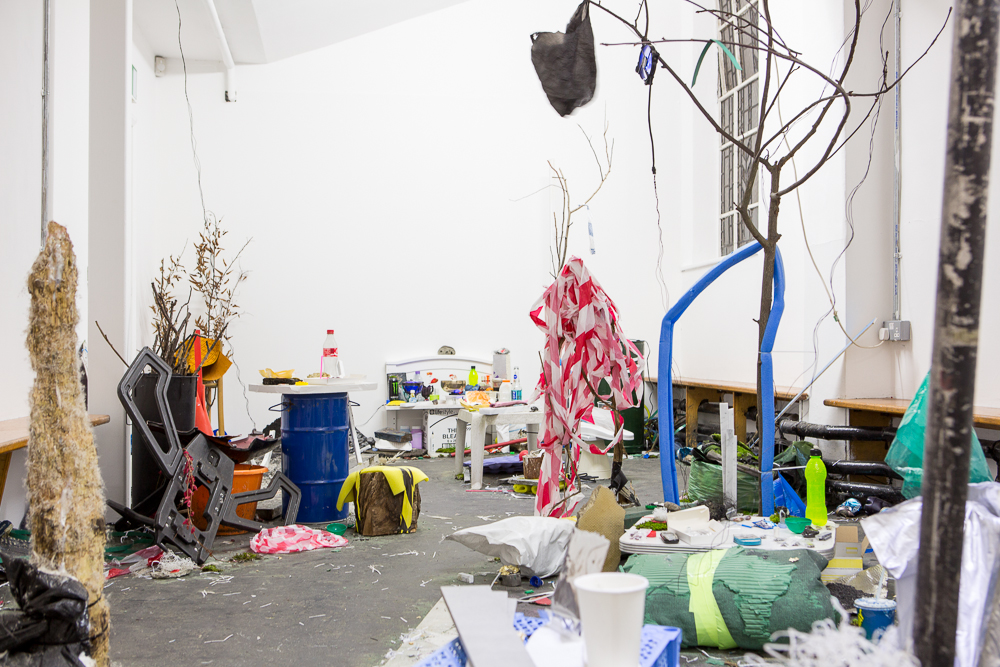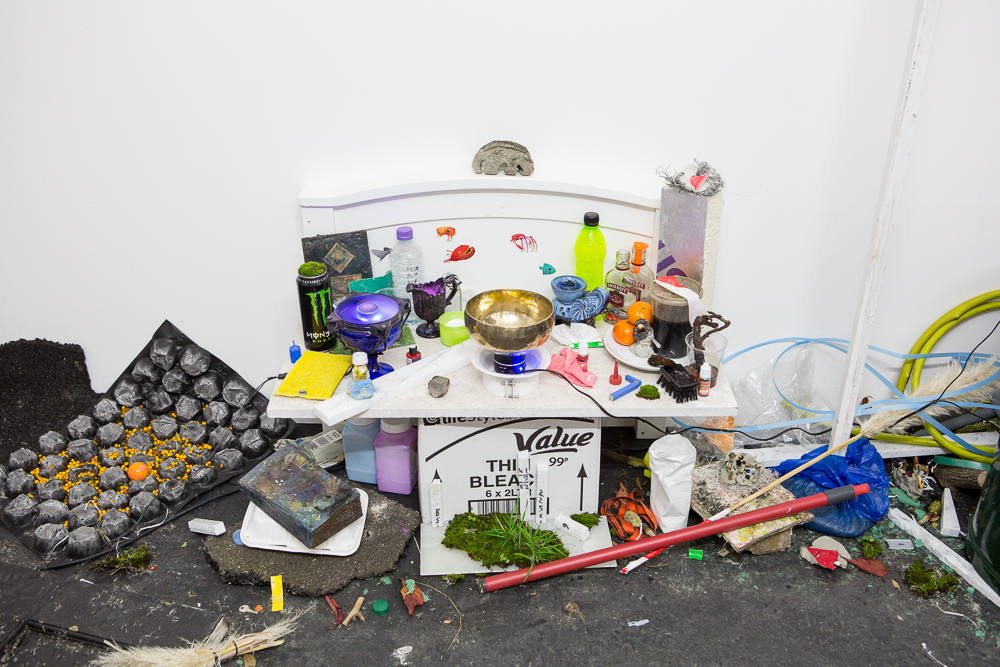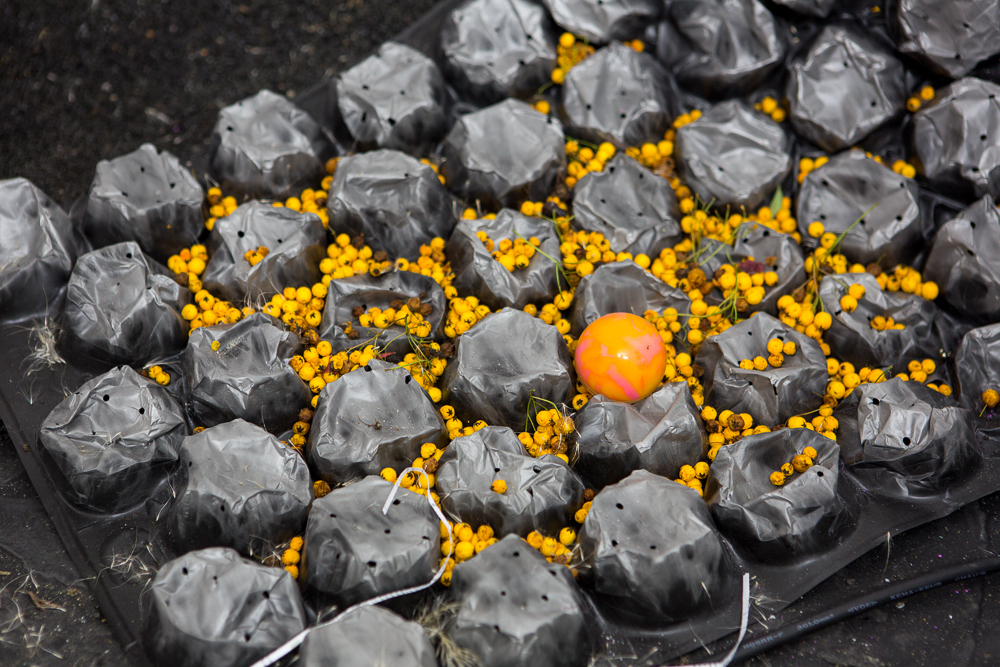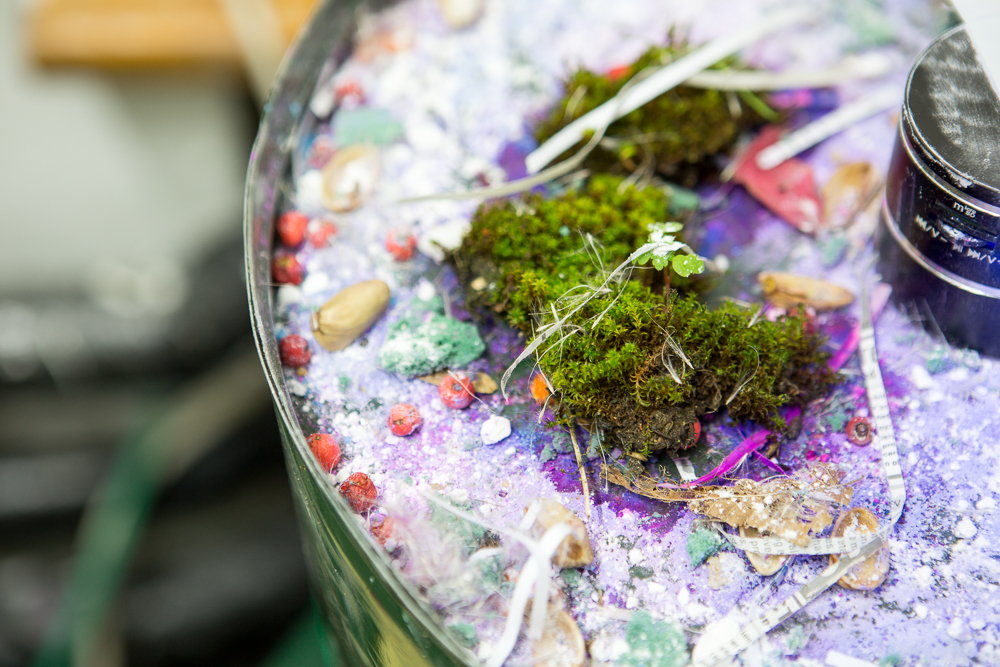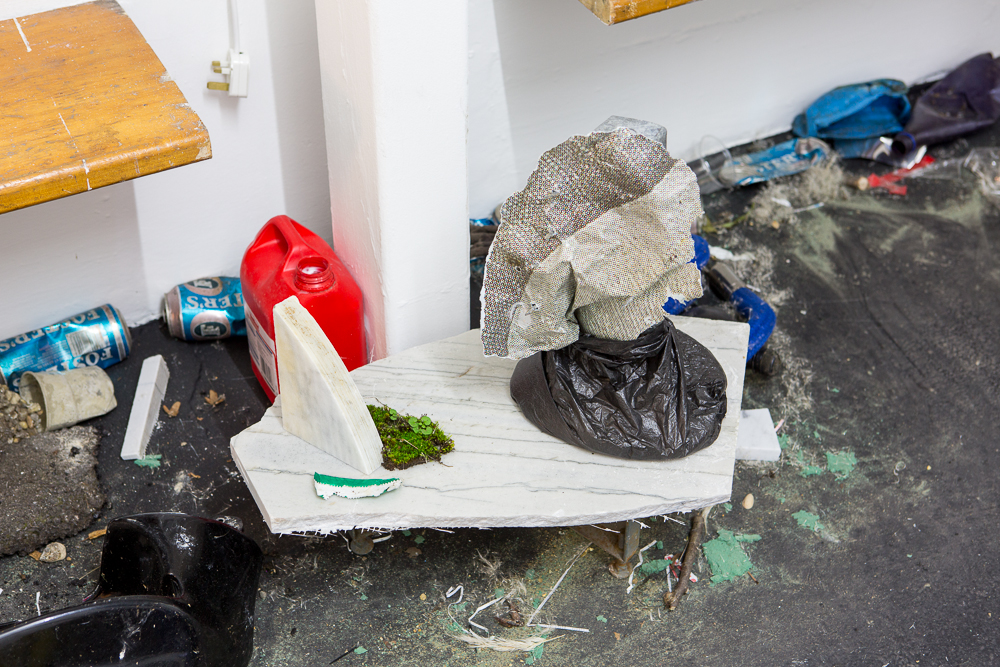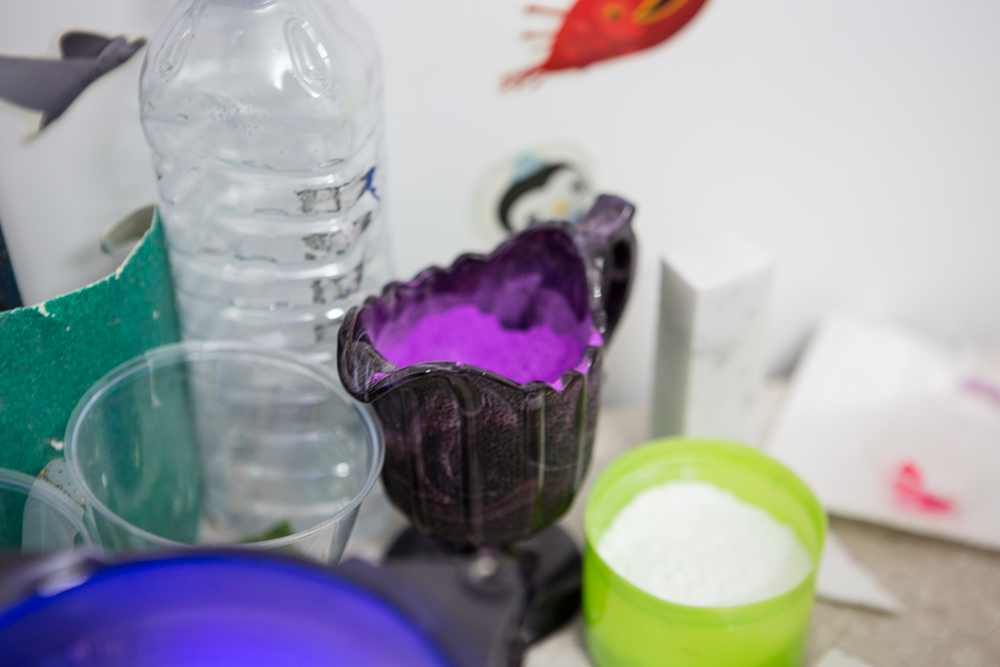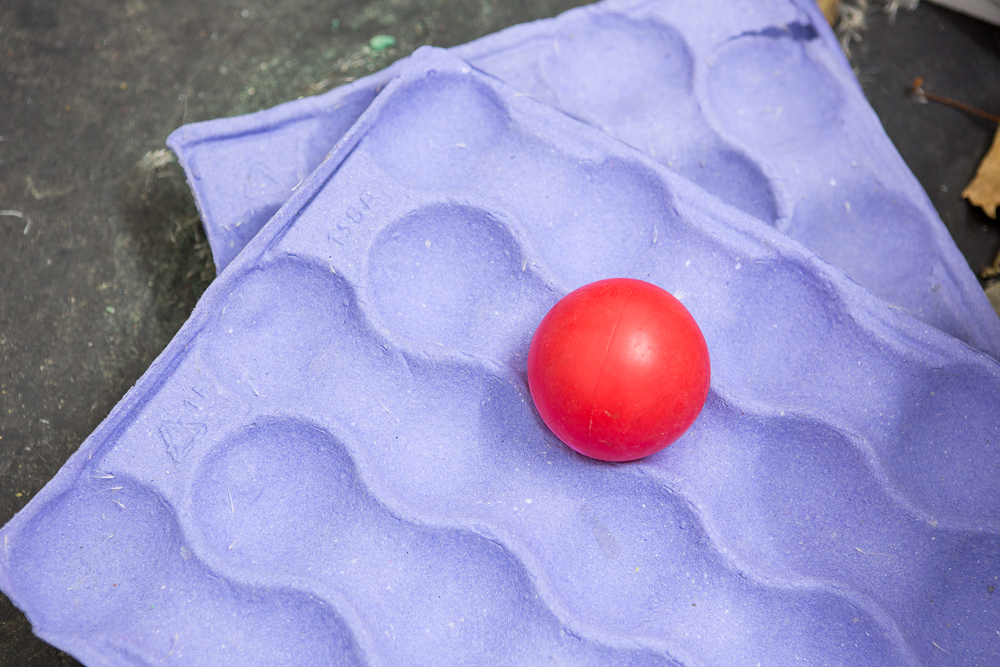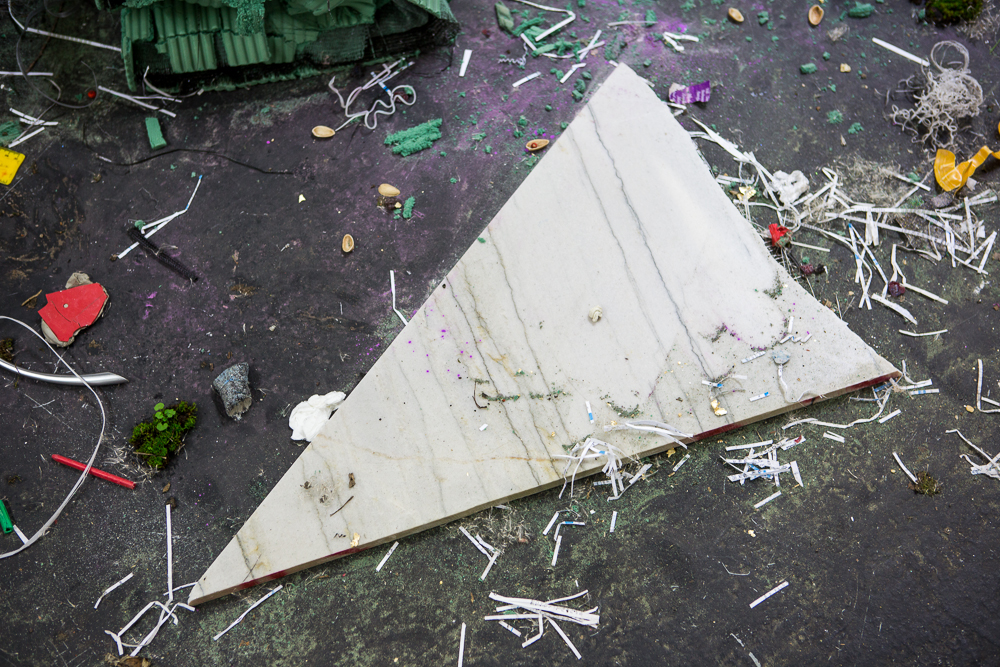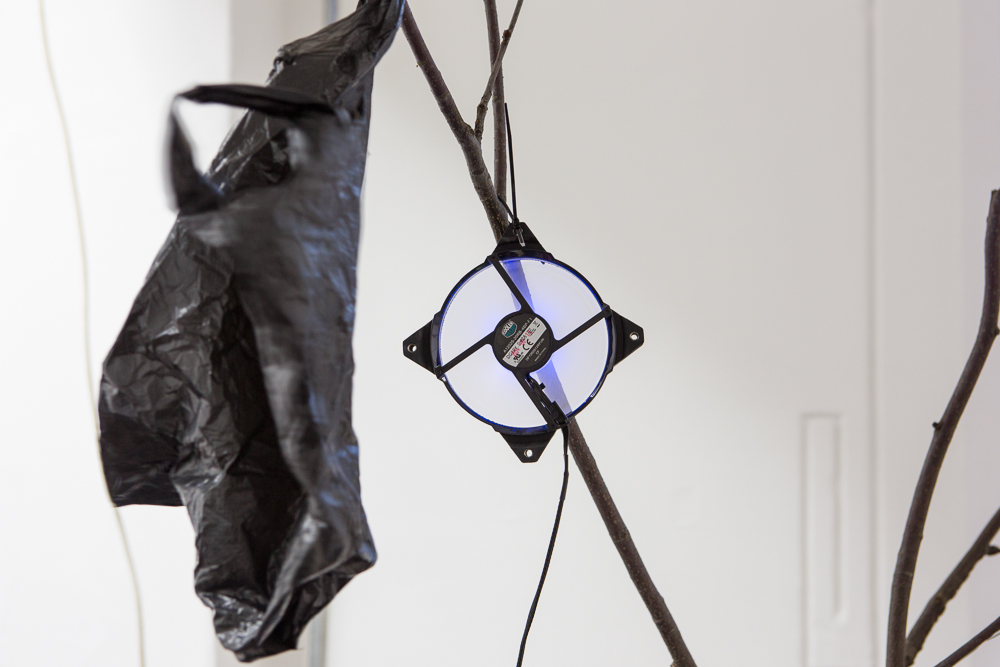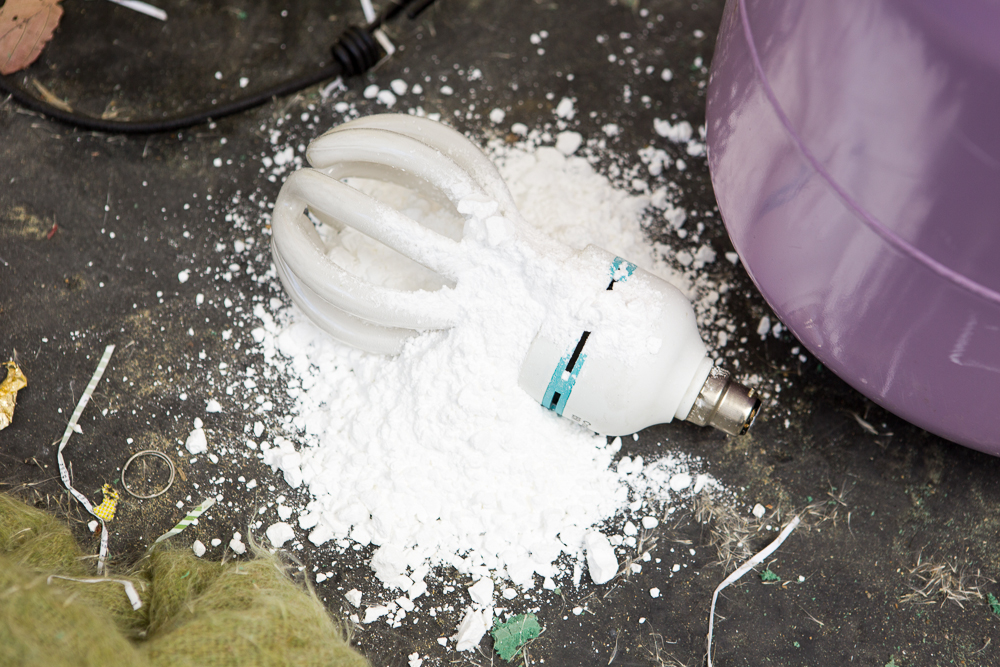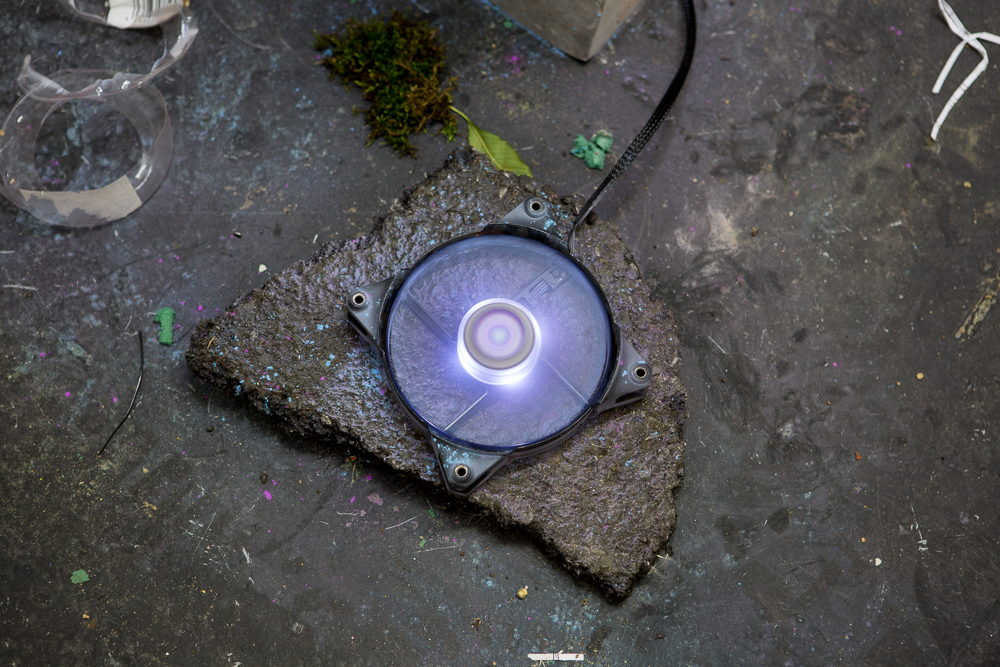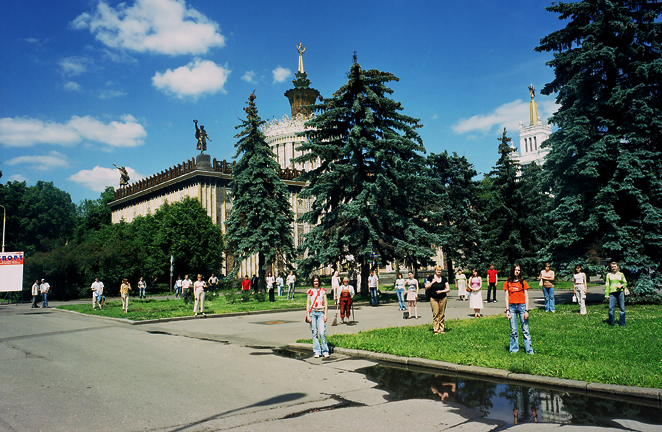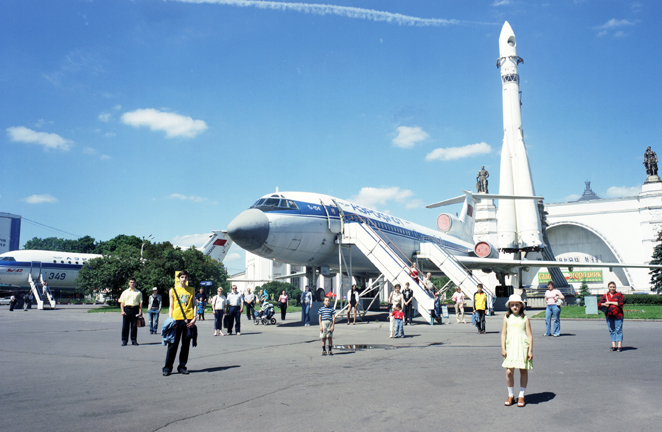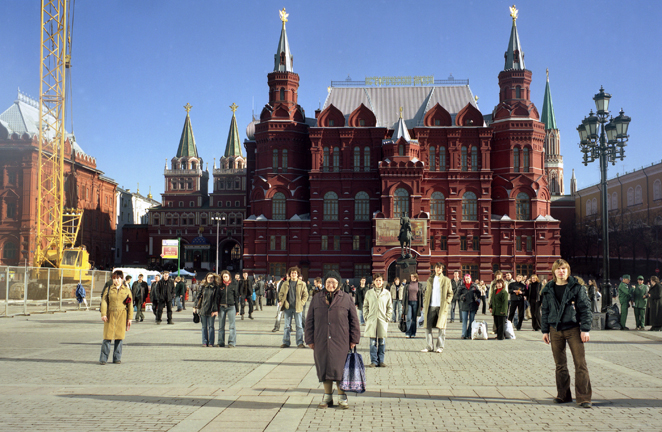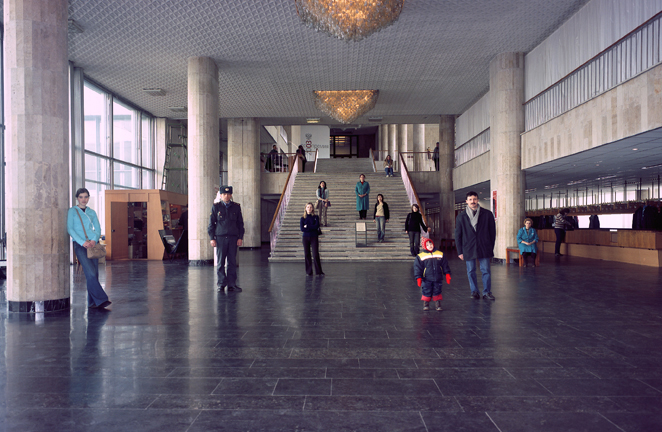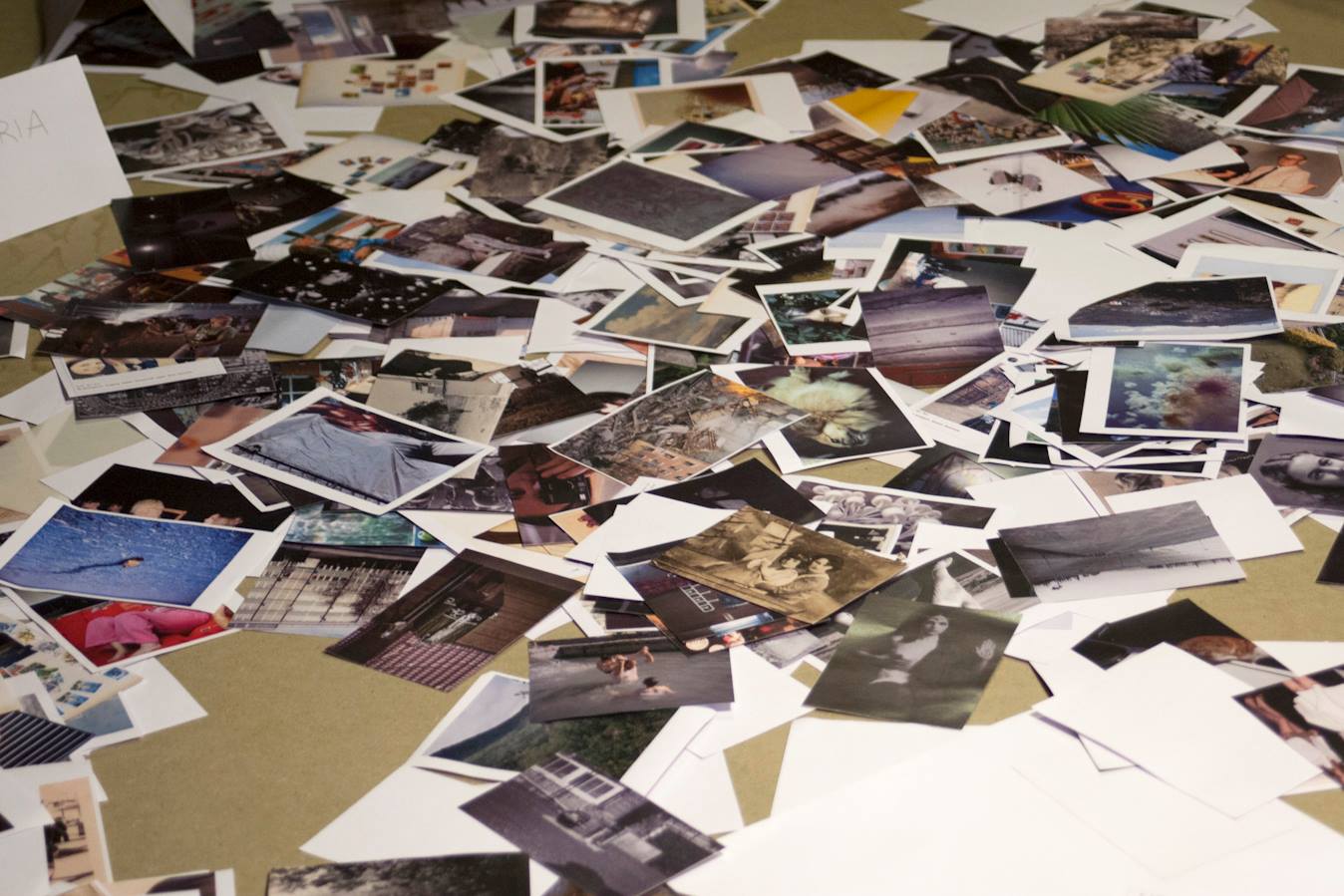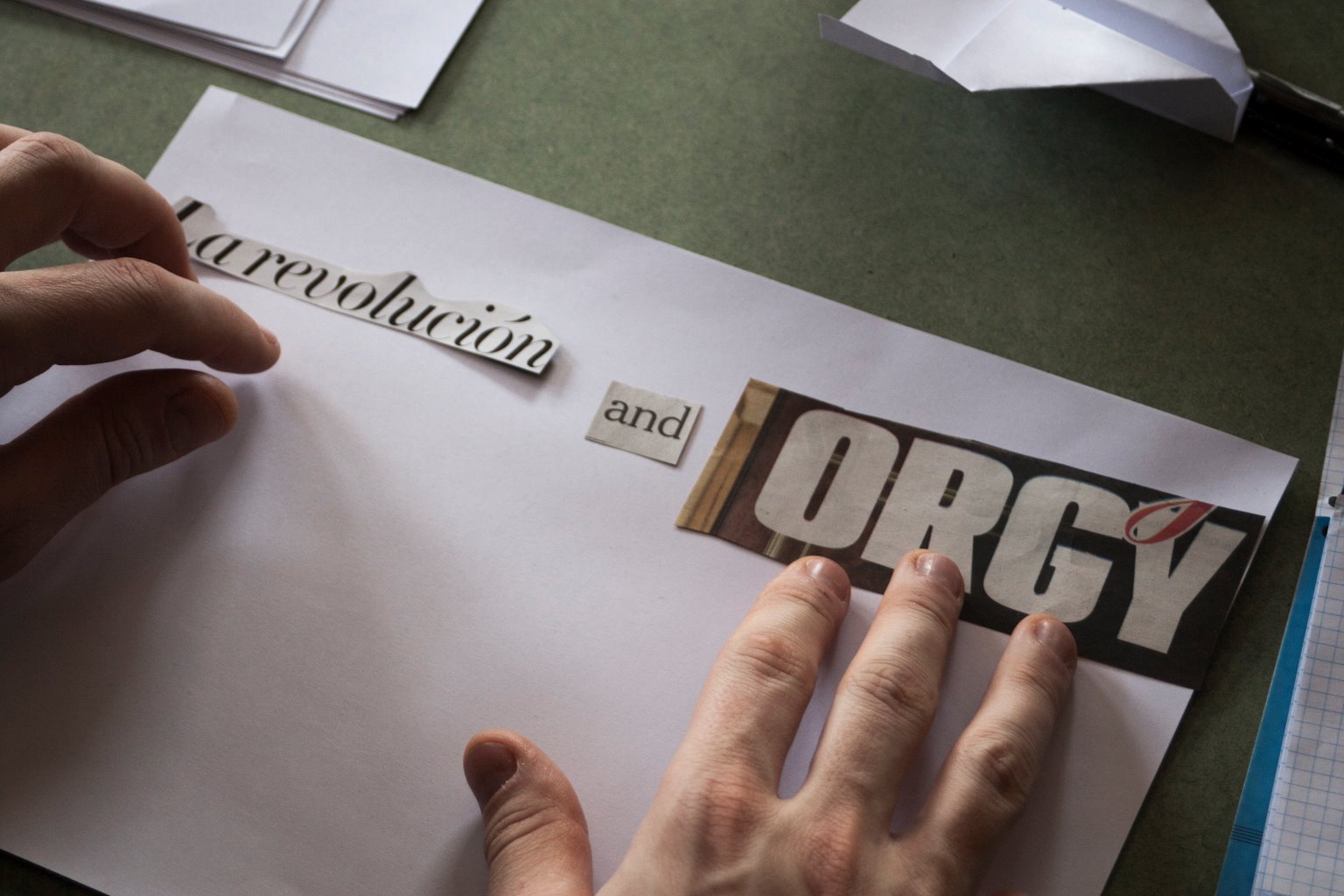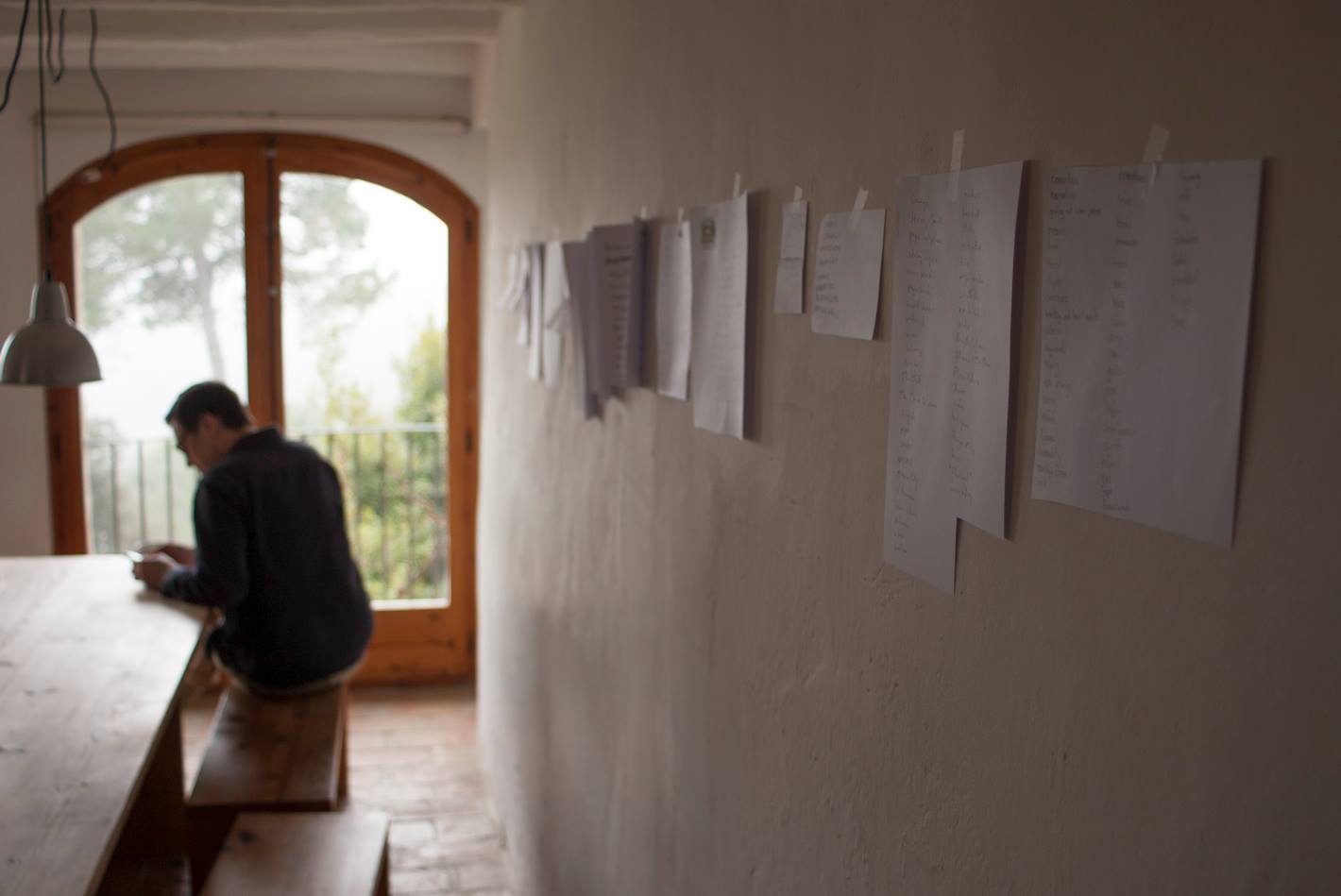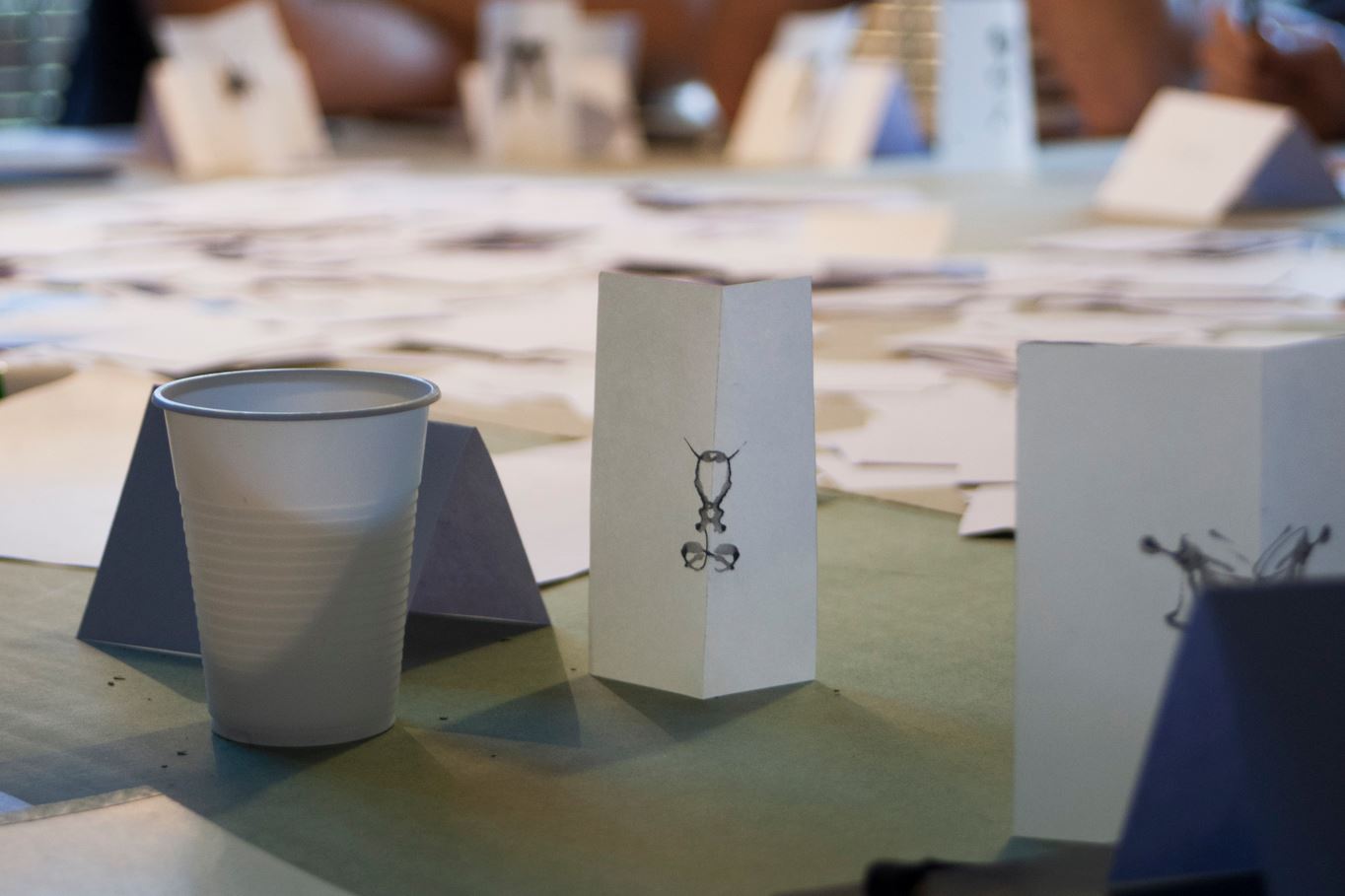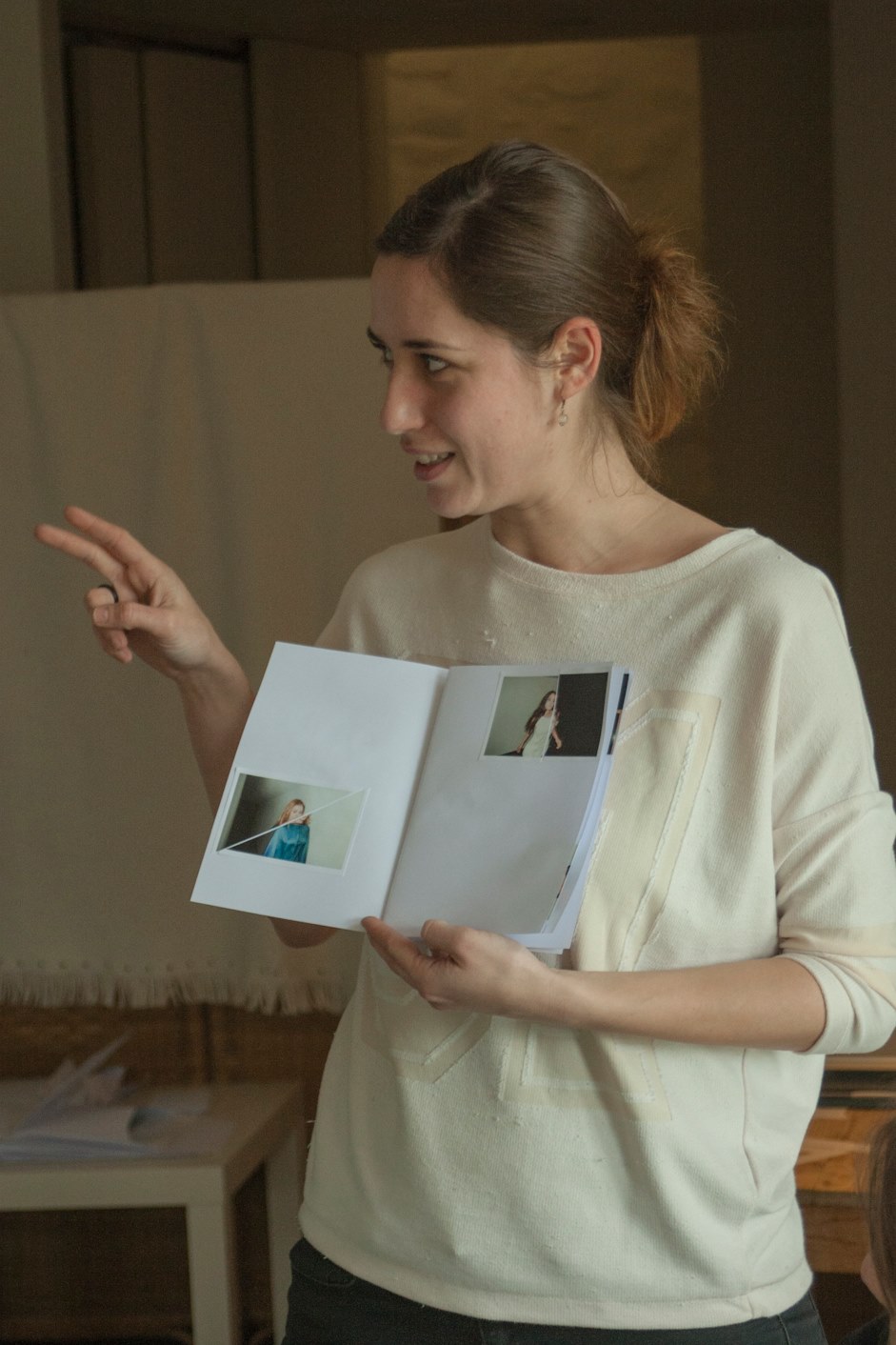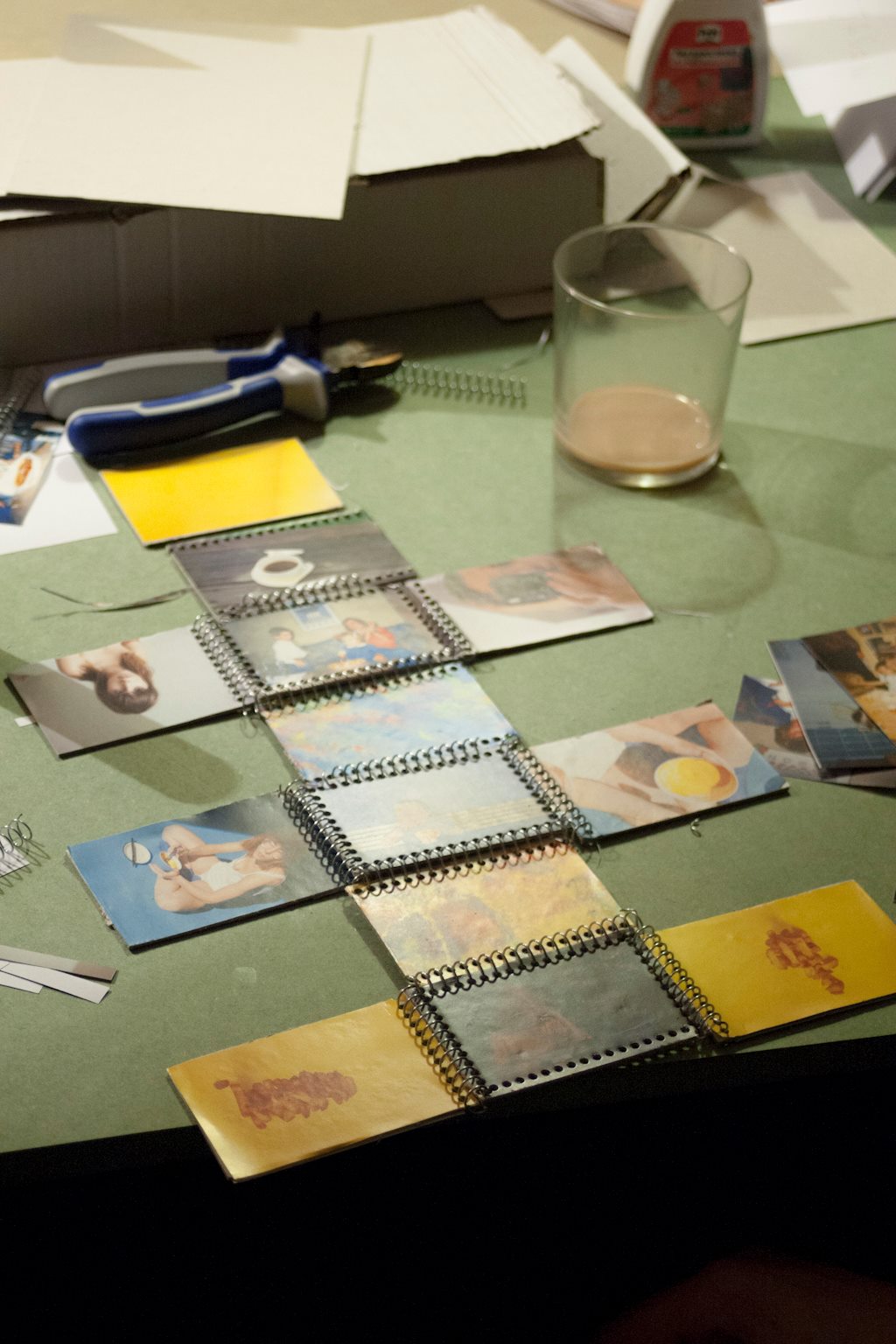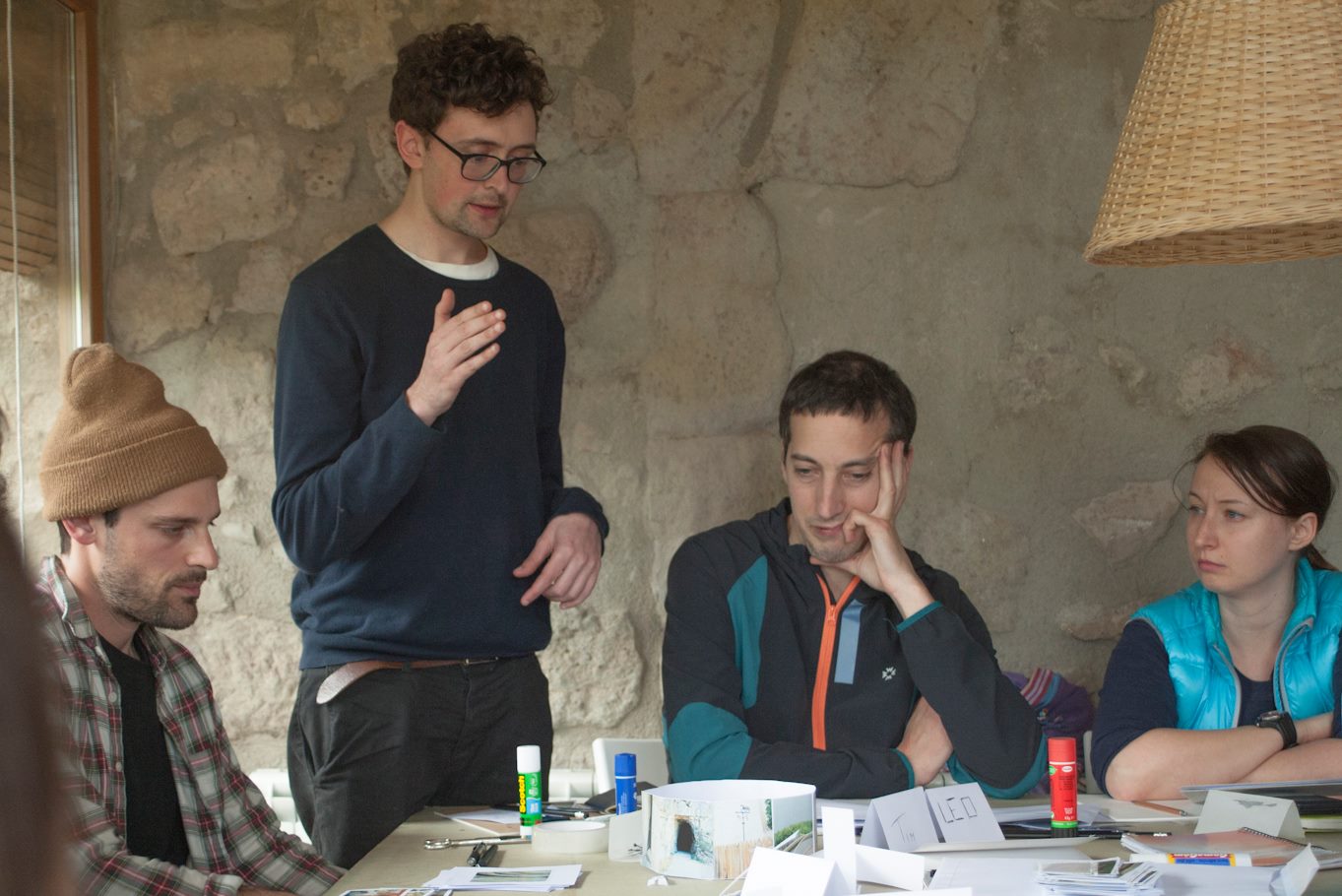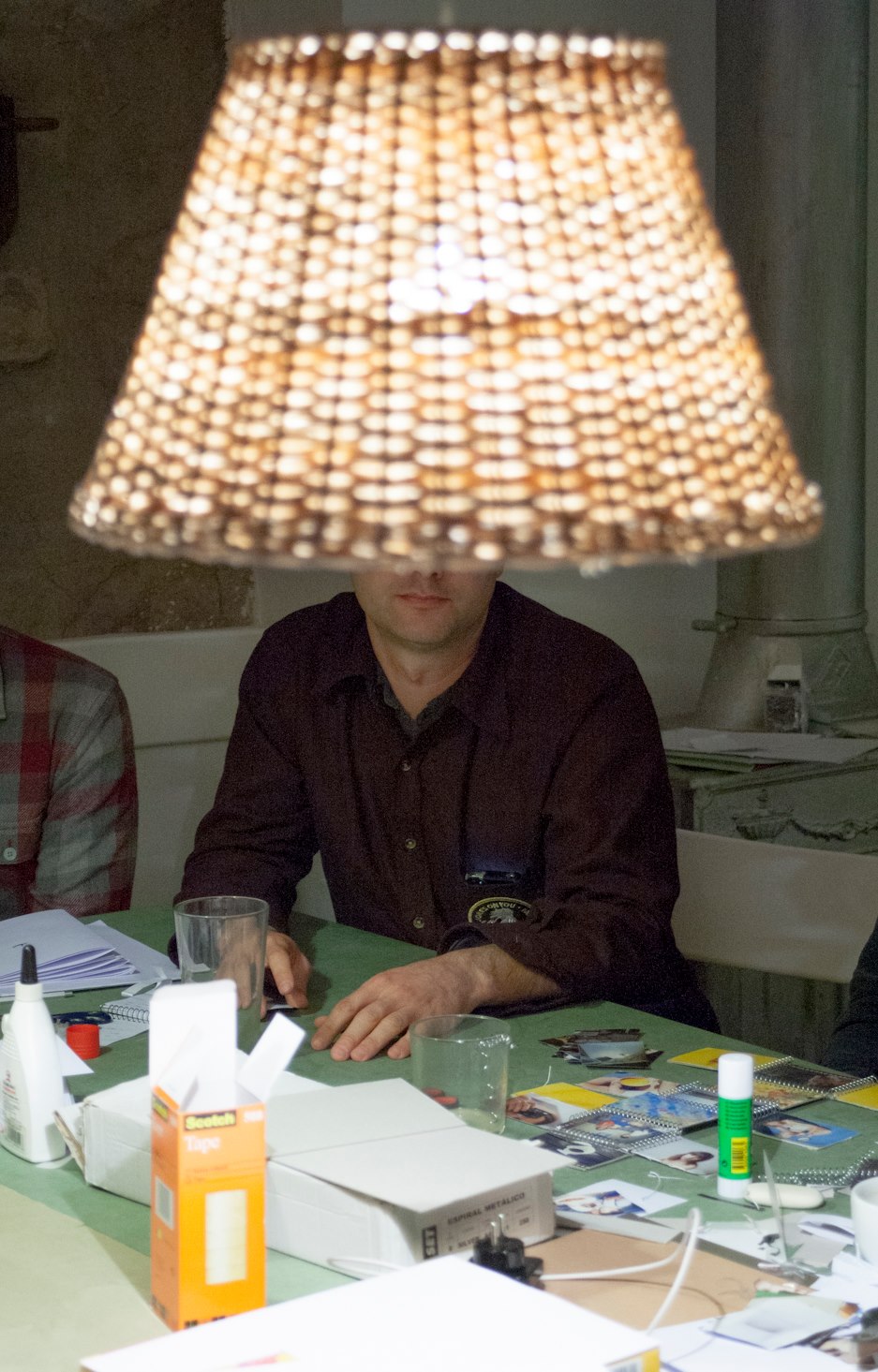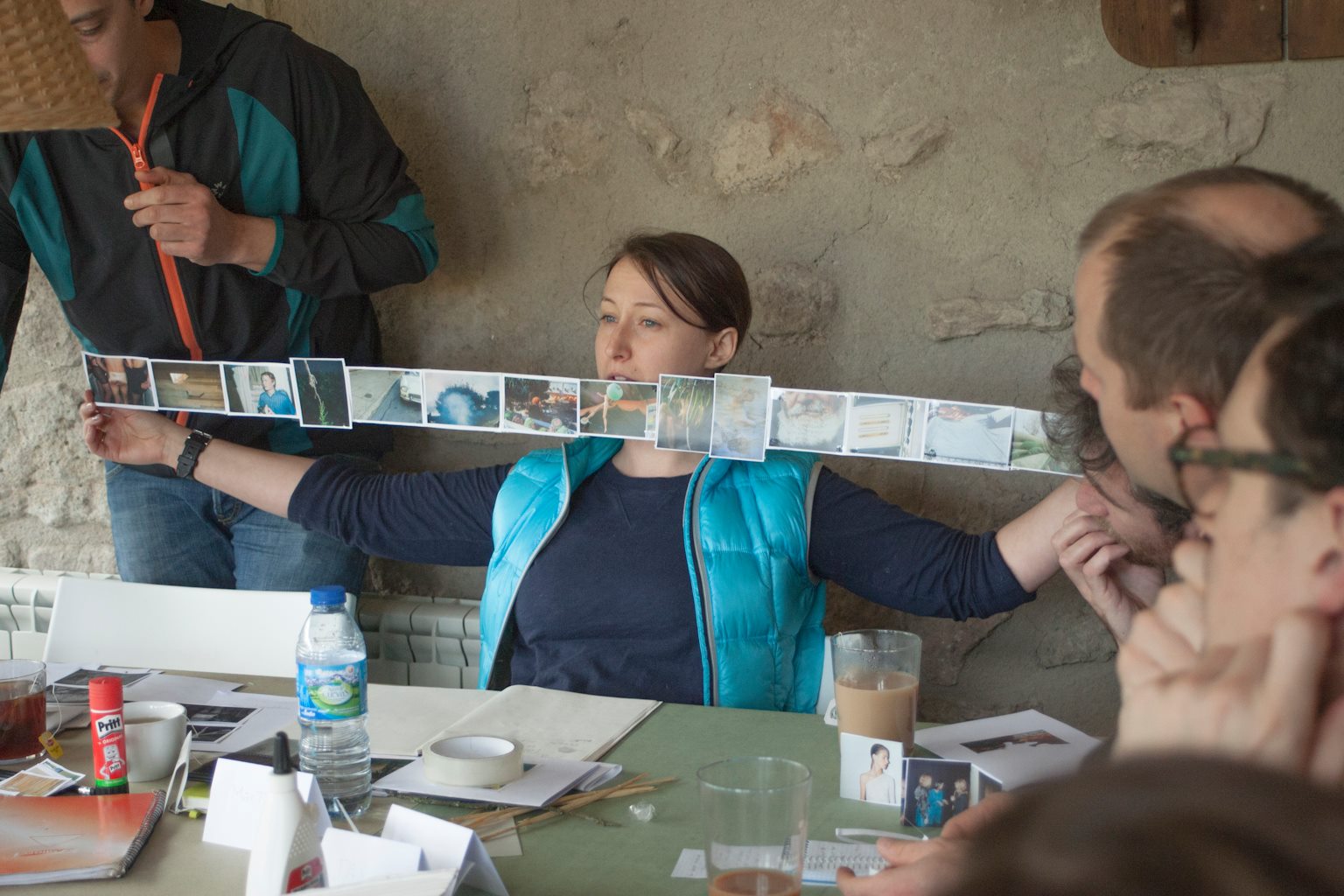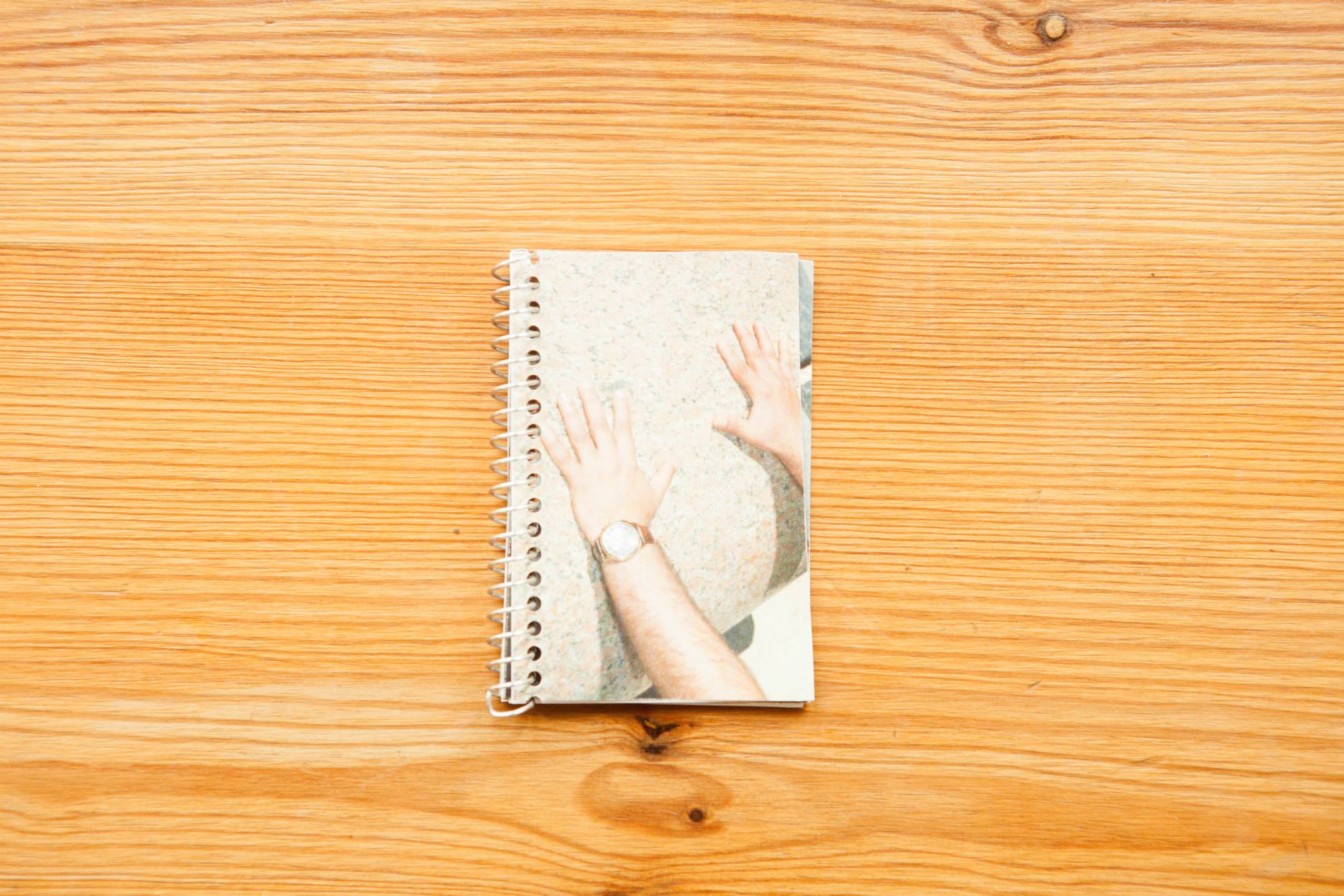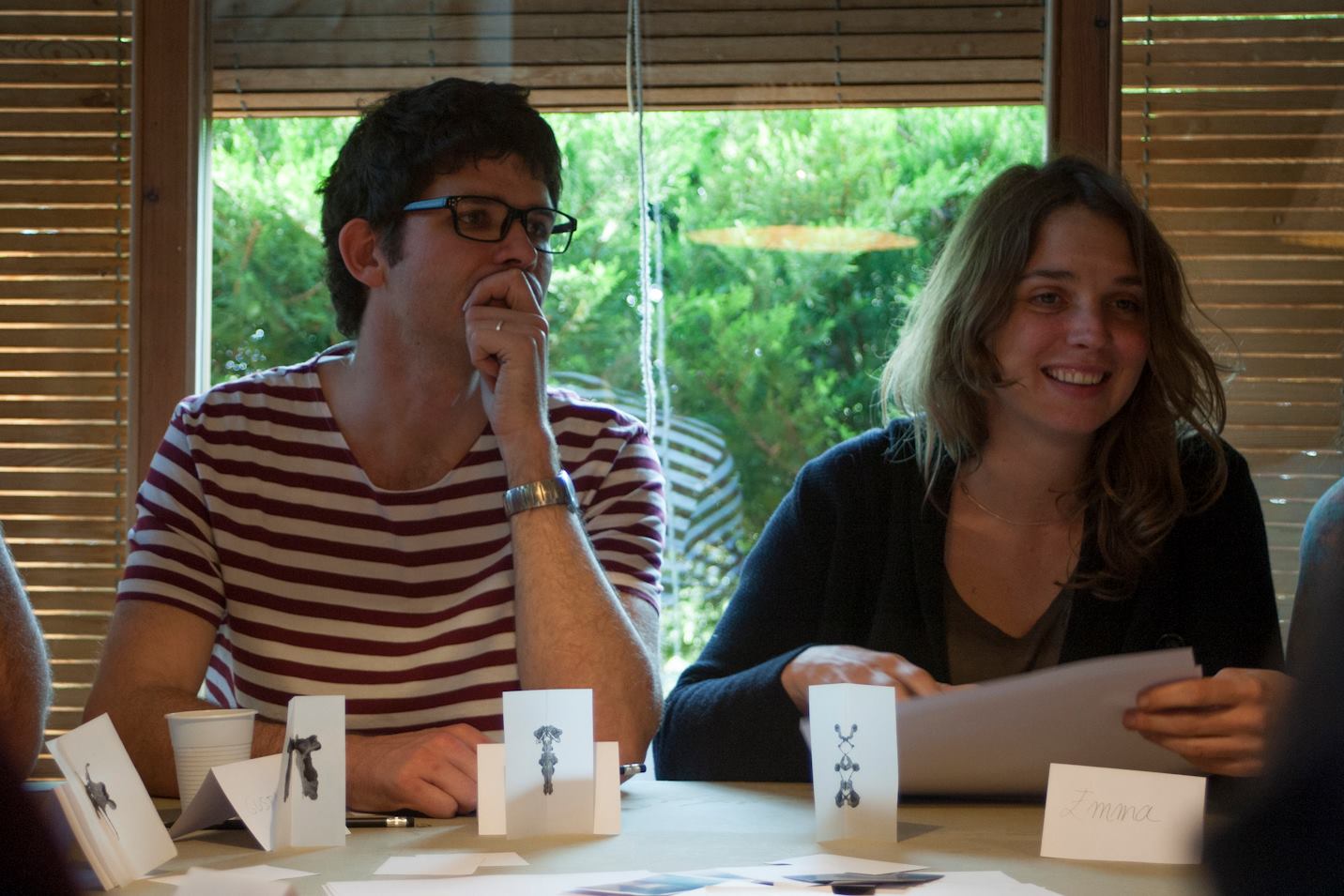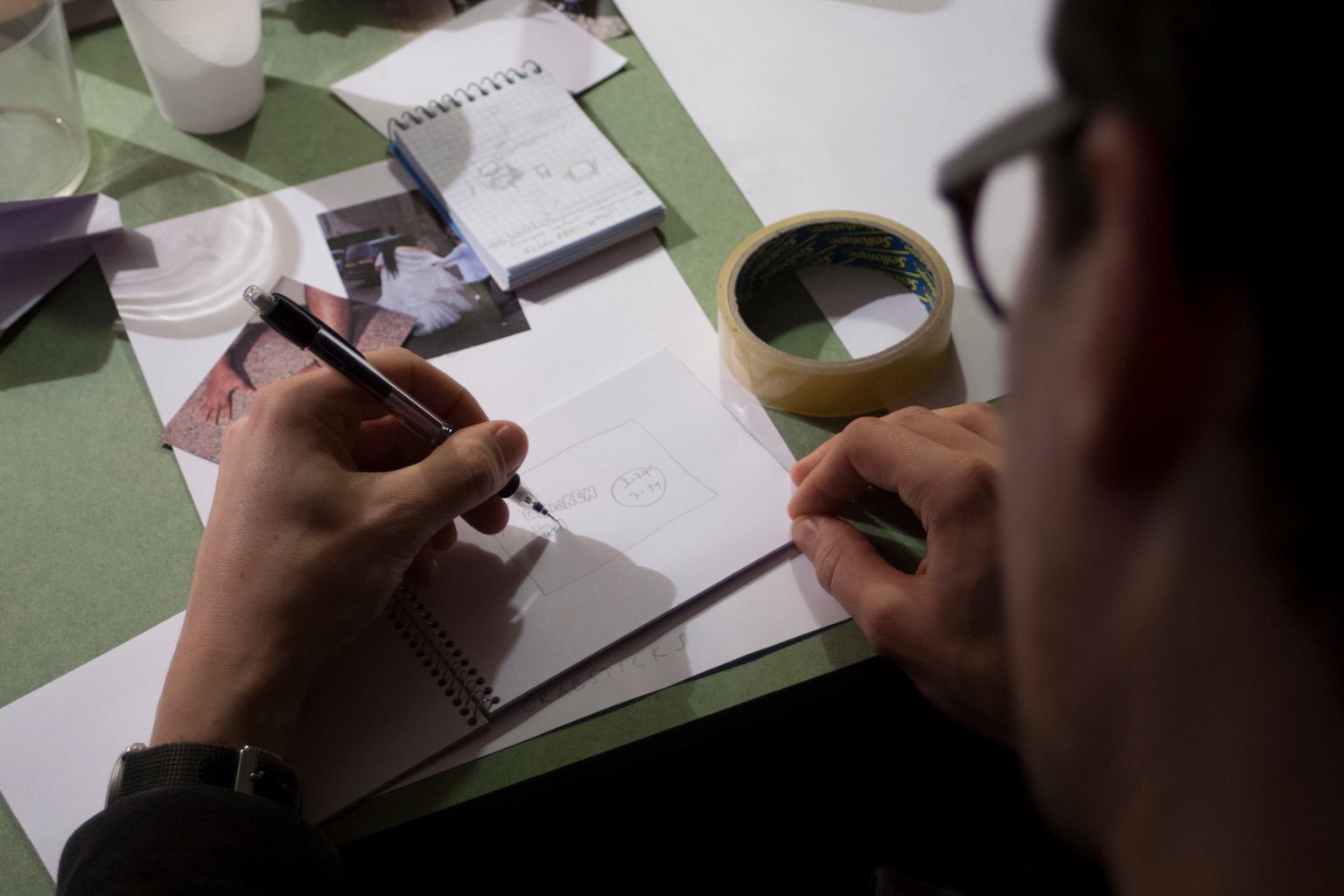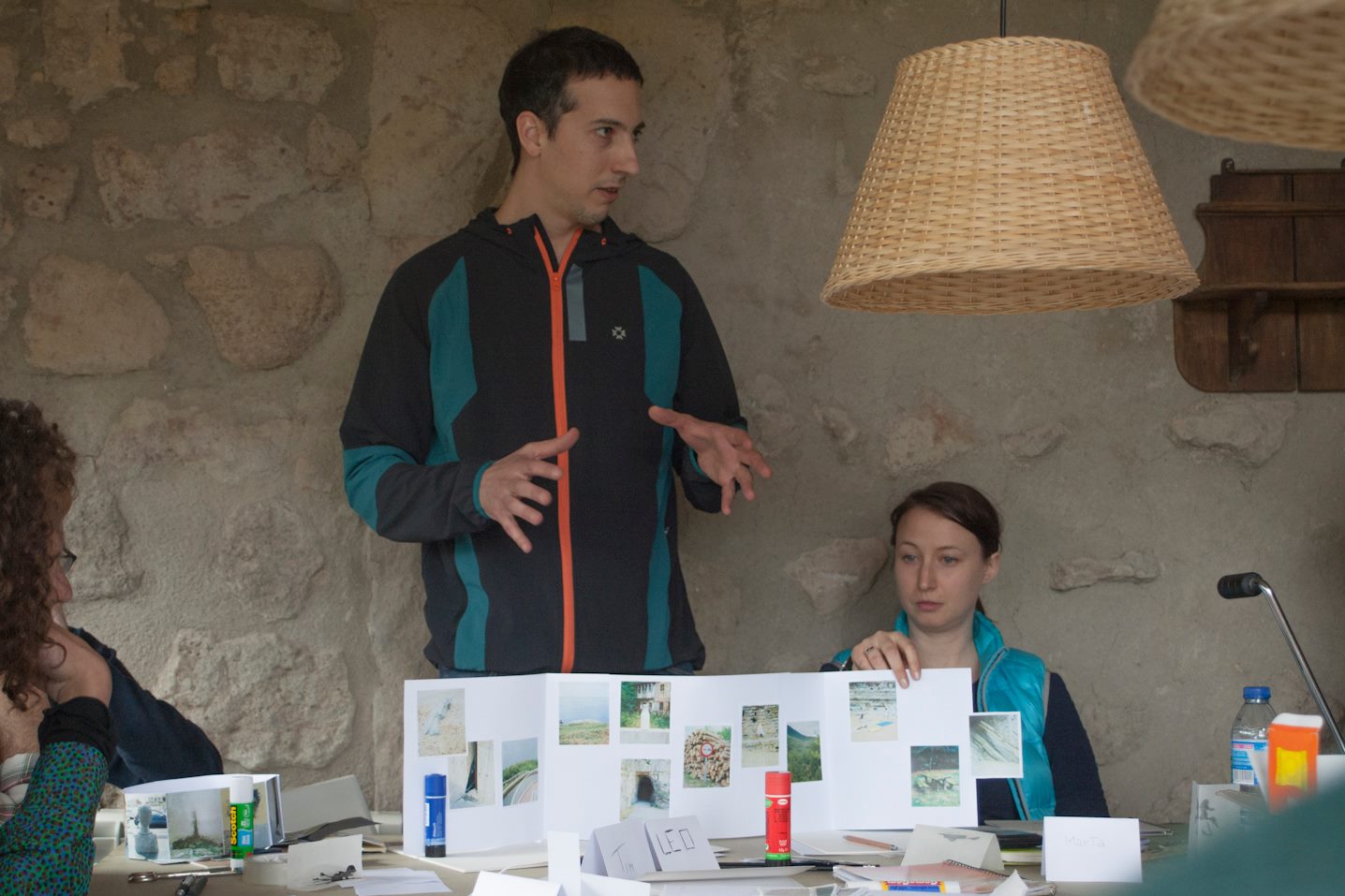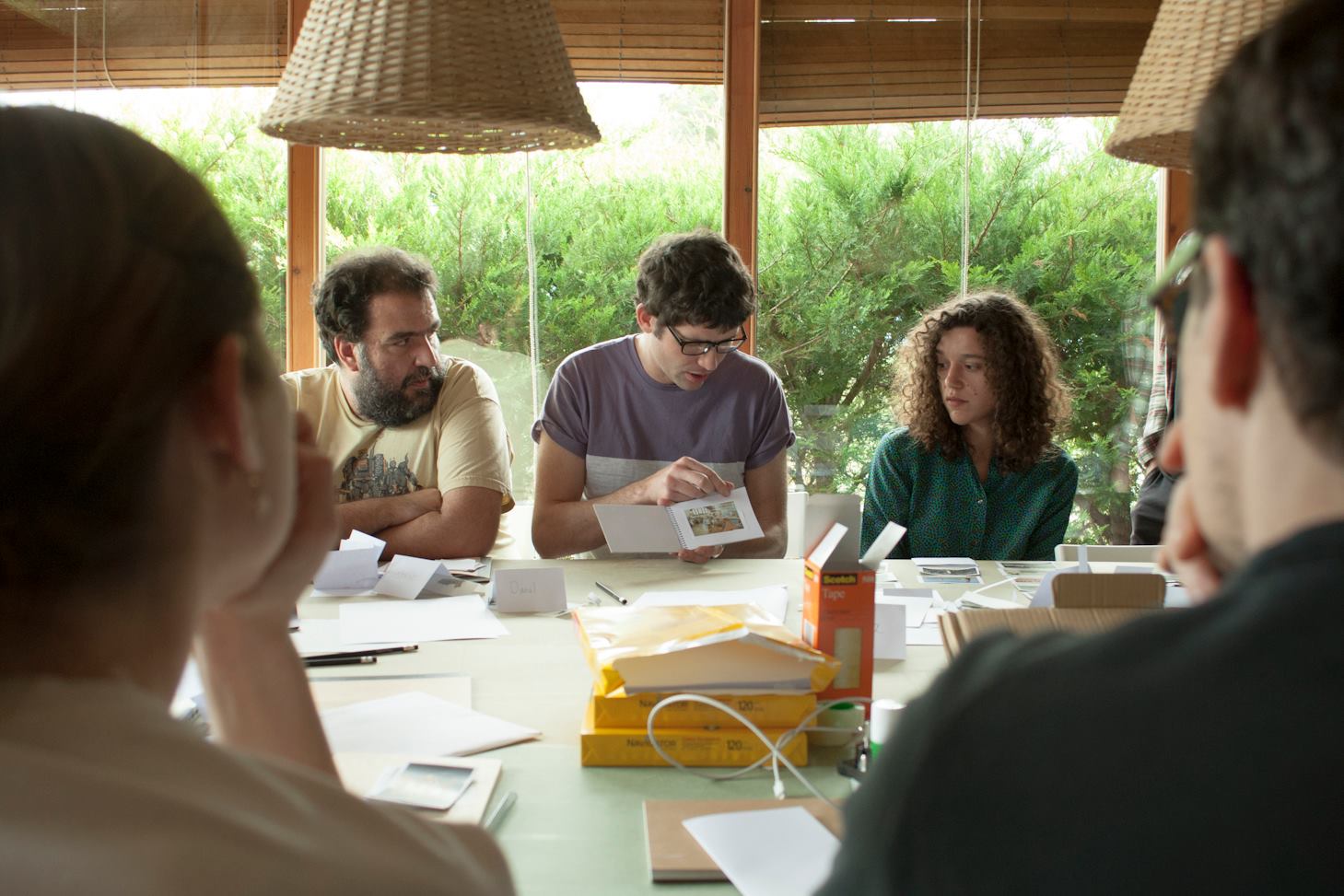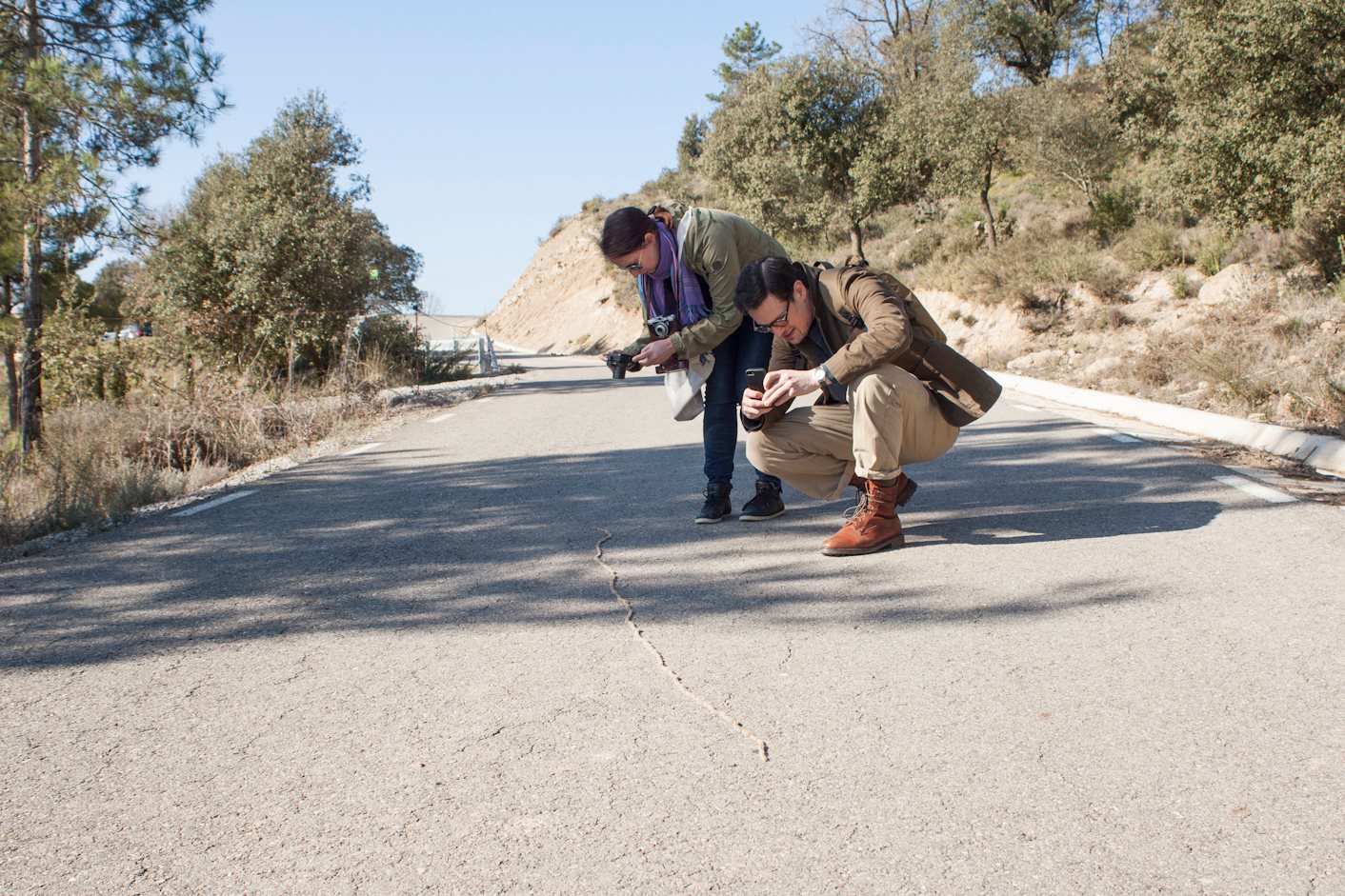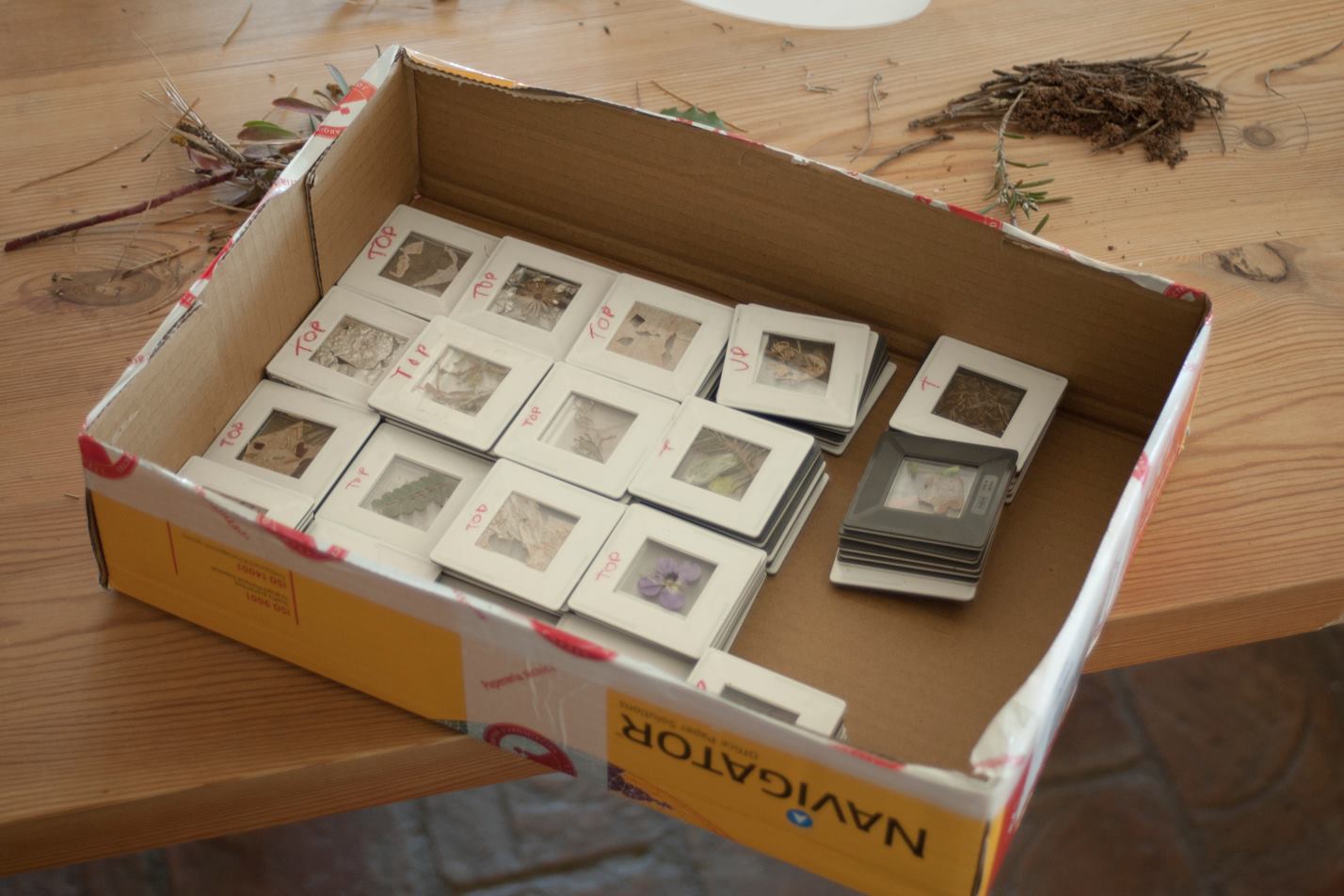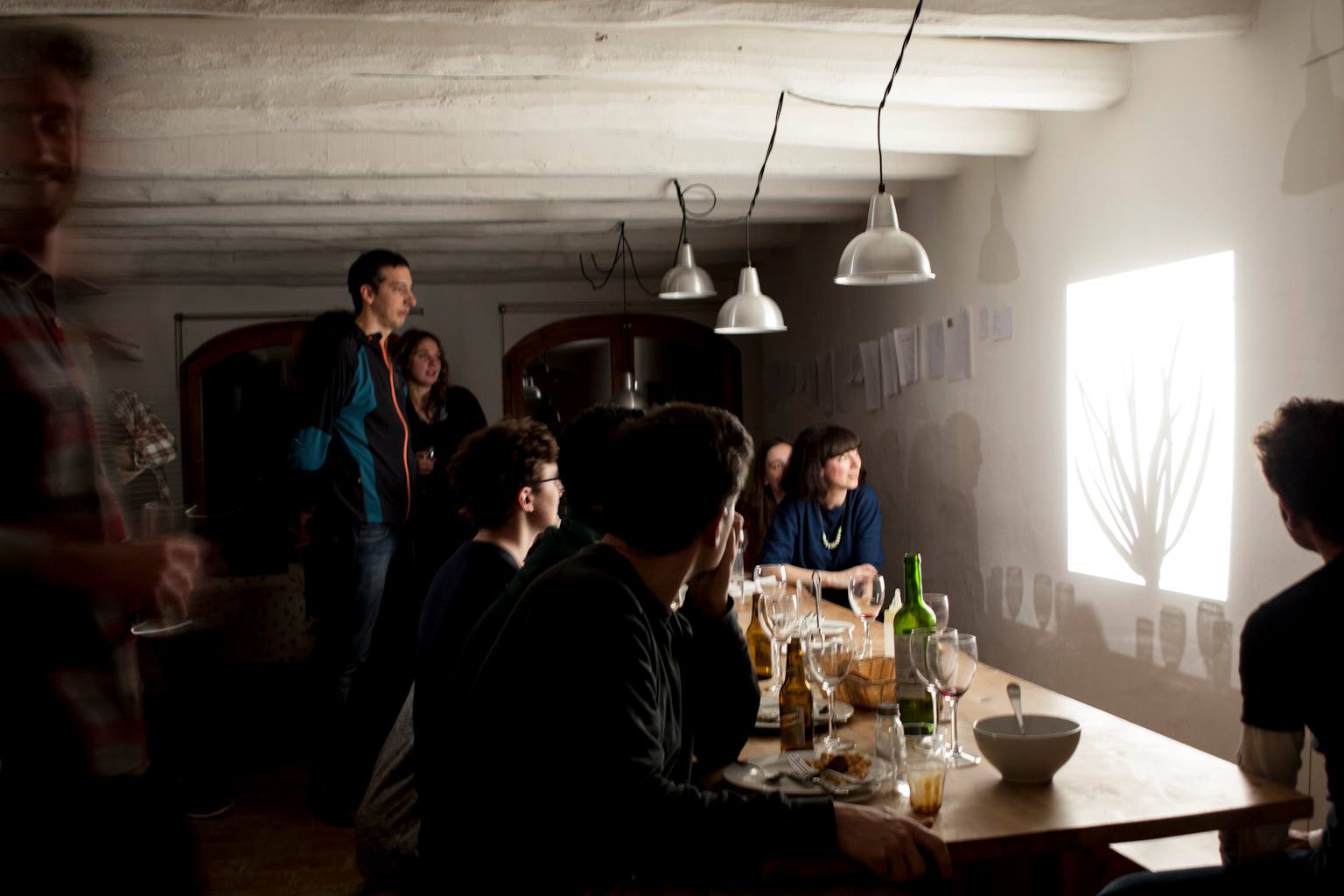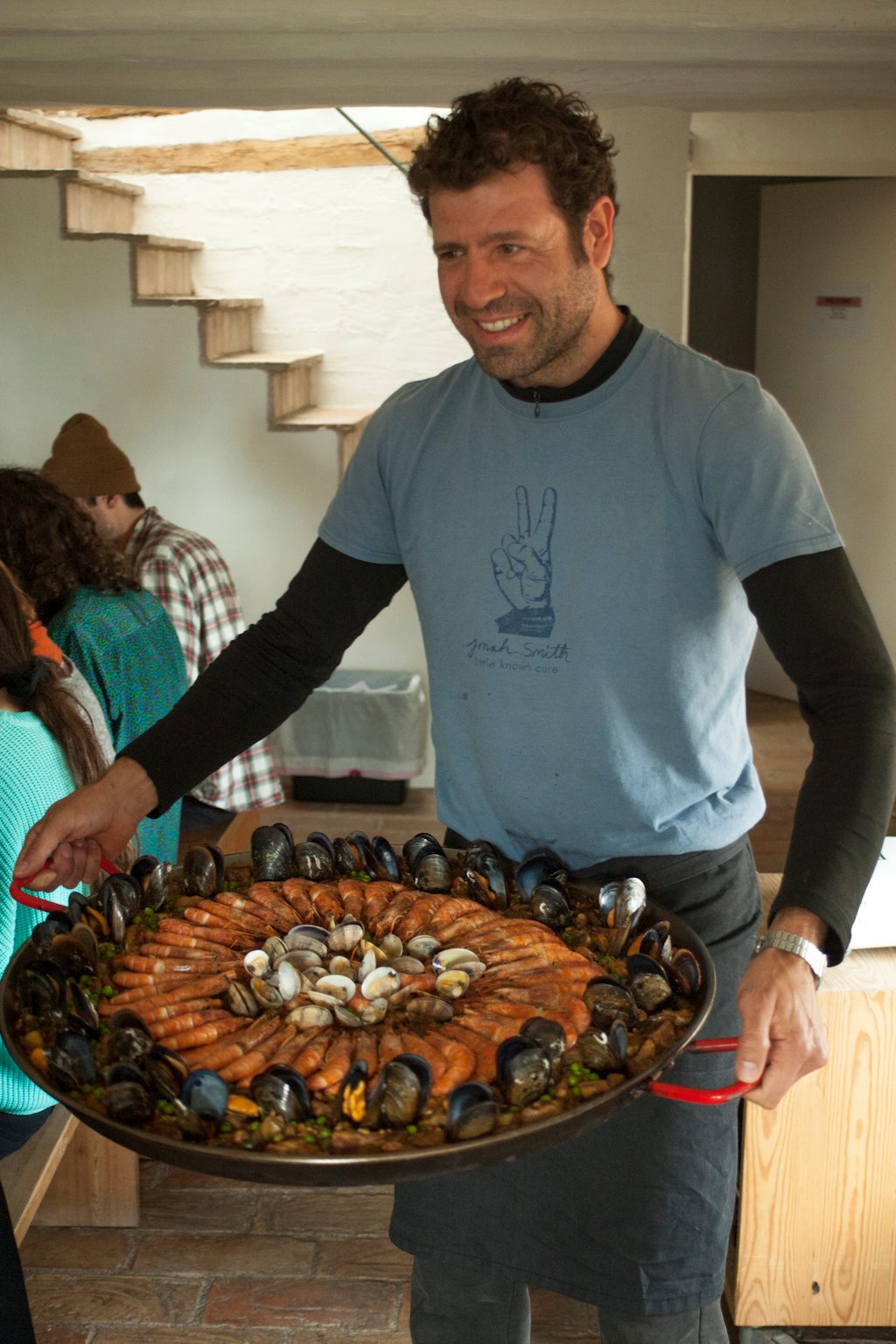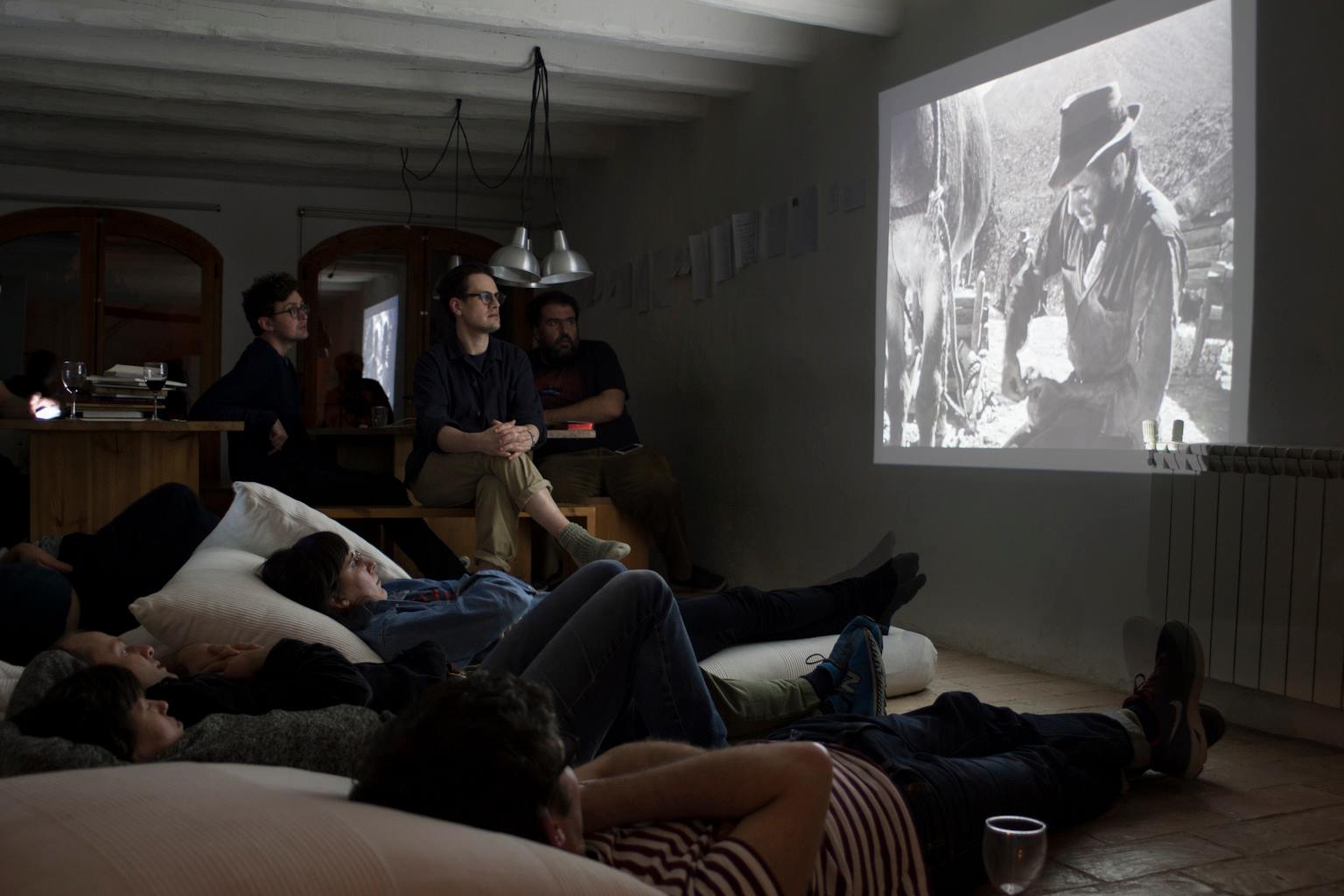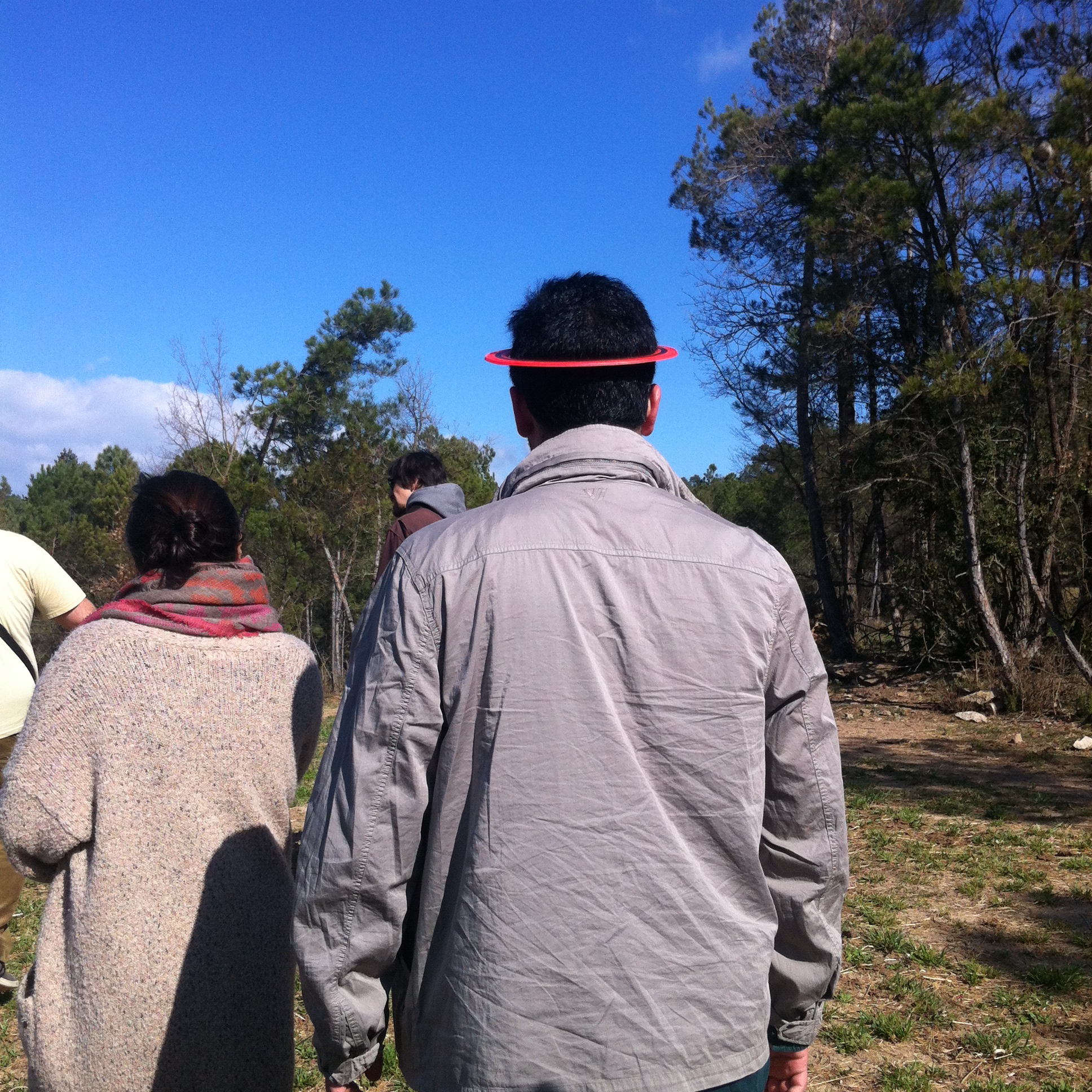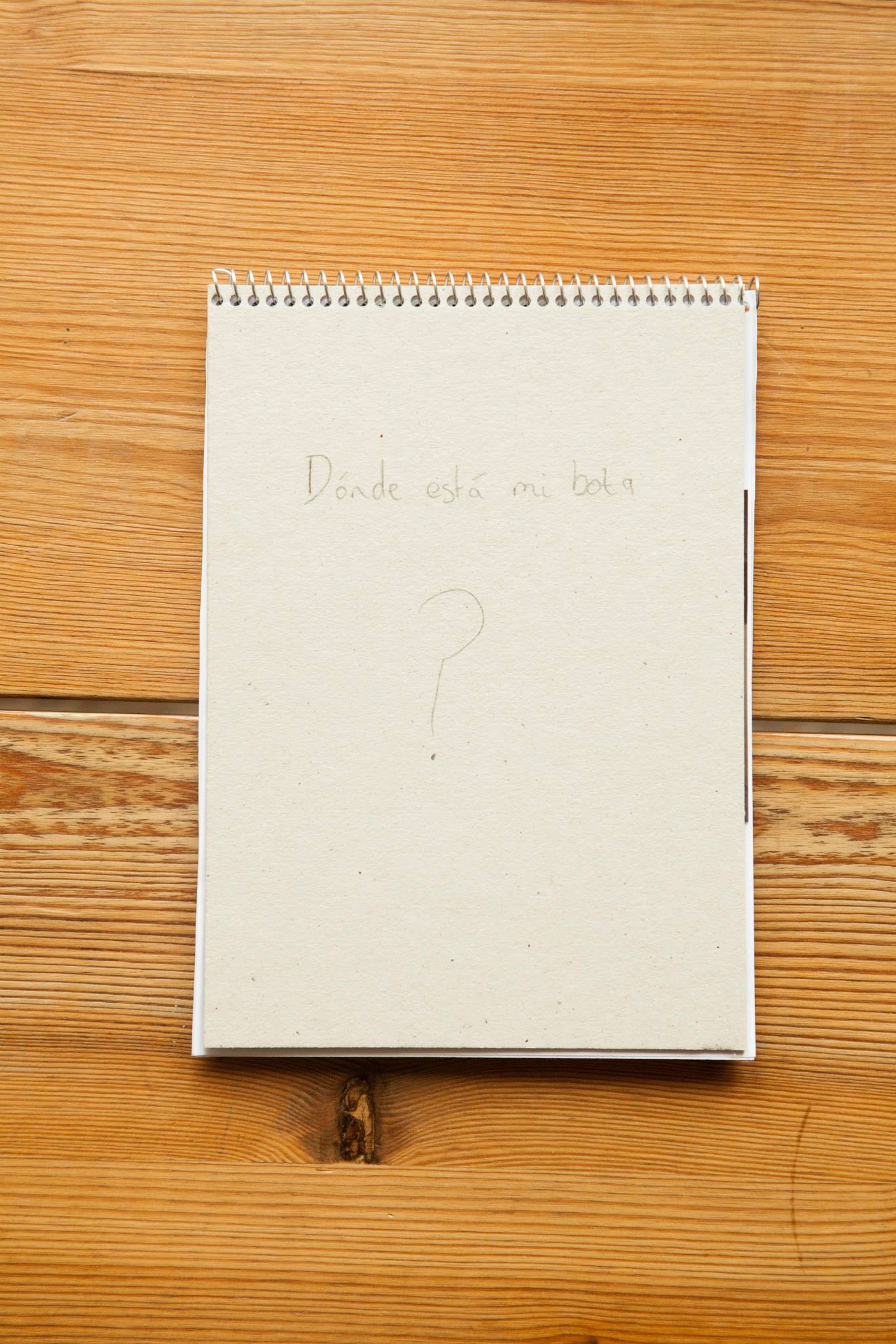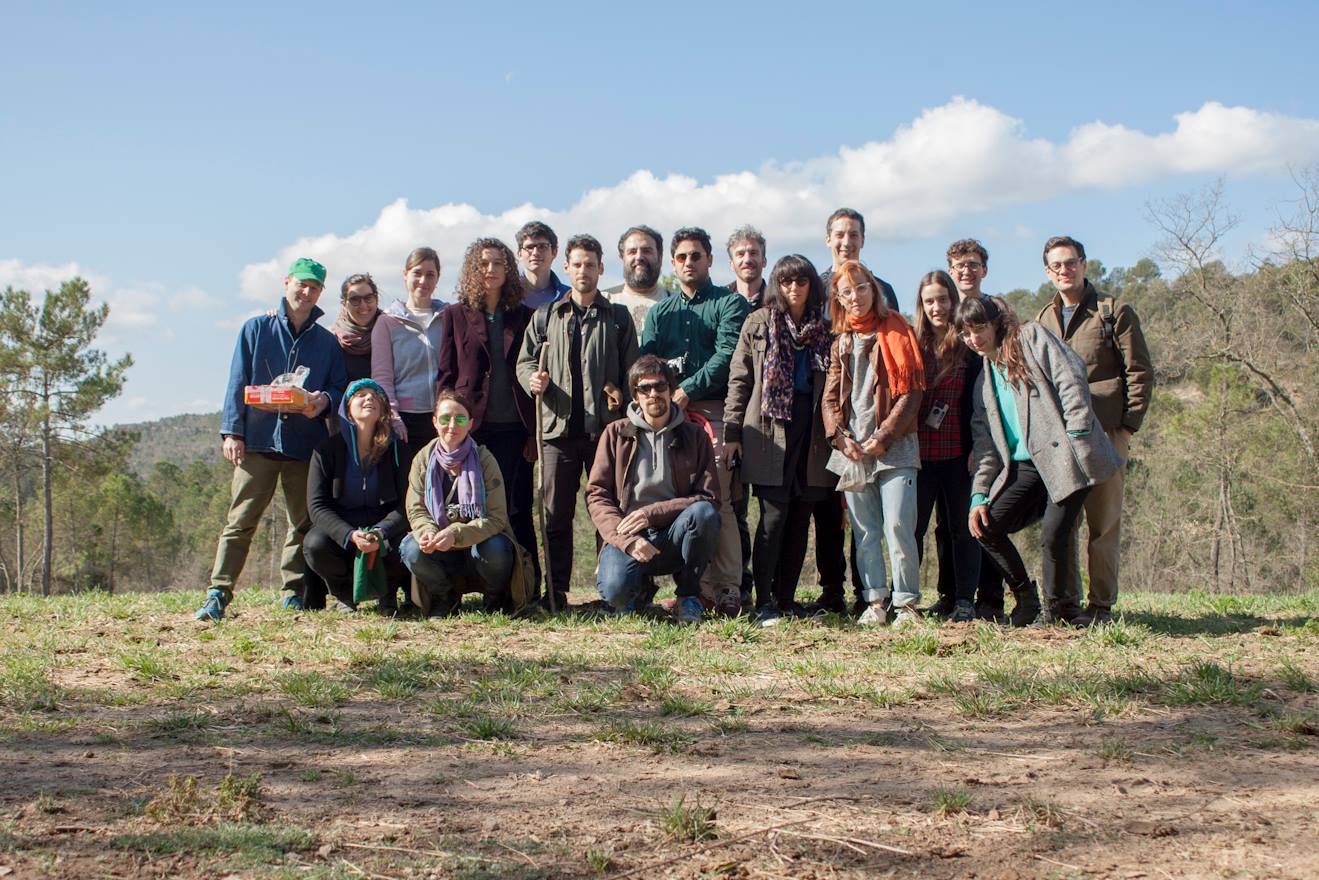Tina Remiz
Artist Feature
Every week an artist is featured whose single image was published by Der Greif. The Feature shows the image in the original context of the series.
Tim Bowditch - Leaf Peeper
Apr 29, 2015
Leaf Peeper is a book about “Momijigari”, the Japanese tradition of visiting scenic places in autumn to see the leaves of the trees as they turn red. Tim Bowditch’s photos follows a Japanese man on the tourist trail around an Imperial villa in Kyoto as he takes endless pictures of the darkening leaves. A text by Matthew de Kersaint Giraudeau responds to Bowditch’s photos with a story of insight, ignorance and blocked sinuses.
Book of photographs with text by Matthew de Kersaint Giraudeau, published by Rokov, 2012.
The story by Matthew de Kersaint Giraudeau:
I’ve not even been to Japan. Also, I don’t understand where his clothes came from. Like, where in my mind the idea for him being dressed like that would have come from. Though I think he looks pretty cool. Just not in a way I could actively visualise. It’s not like that’s some pre-existing idea I have of stylish dressing, and I haven’t seen it anywhere. I haven’t remembered it from somewhere and reproduced it, though I guess the whole thing would be an act of my subconscious anyway, so I wouldn’t necessarily know.
I’ve always had trouble with my sinuses – it’s not like recently it has been particularly bad. It comes and goes. The headaches were bad, but I honestly don’t think I’ve had one for maybe a year. I think I have small nostrils. Restricted air flow. Easily blocked. It is definitely worse when I drink alcohol. I think maybe just the sheer amount of liquid. You never think about that do you? But when you drink beer all night you’re ingesting like 10 pints of liquid. That’s mental. You wouldn’t sit down and drink 10 glasses of water in five hours. You’d die. Water on the brain like that pilled up girl in the nineties. I remember reading about that at the time and thinking that drugs were really scary and then later when I was older and doing drugs, thinking that her friends were morons for letting her drink all that water. Plus when you realise that almost all drugs are better when you’re pissed then the idea of drinking water goes out the window anyway.
Now I’m thinking about how good it would be to have a suit like that. One you could wear all the time. Because in the dreams he is always wearing that suit, with the little hat, and then in the kebab shop he was wearing it too.
It could be something to do with the wheat or something – the wheat in the beer. Maybe that makes my sinuses worse. I always think that everyone probably has a bit of a wheat intolerance, and also maybe lactose. Cow’s milk is weird – apparently we just aren’t built for it. Come to think of it Japanese people don’t eat milk products do they? And apparently westerners smell of milk.
Anyway, I’m just not a hardy person. A weak stomach is a meaningful bodily metaphor for me. I understand it. Even as I’m writing this I’m feeling a bit jittery and nervous because I’m hungover and I’ve drunk some coffee, and it isn’t the caffeine making me feel weird, but the way my stomach reacts to the hot coffee. I can feel it, the metaphor, where it comes from. It’s not an analogy – it is just a straight description of a physiological state.
So when I’m drunk I’m sort of breathy. Not wheezing or coughing, just a mouth breather – maybe some sniffing. Specially in the cold – and then coming into the heat of the kebab shop so warm like that. My glasses would have steamed up, I’m sure of that – though I can’t remember it happening. Maybe that’s why I didn’t see him when I first walked in.
Because I would have recognised him, from the dreams. Definitely. He’s been there for years. Always the same, I follow him round these gardens. This old Japanese guy, and he is oblivious because he is taking photos of all the leaves which are all golden and brown which is beautiful but sort of morbid as well. The dream is really about the feeling – I have no idea why he is Japanese – the feeling that he is going to turn around at any moment and the situation is going to be embarrassing and hard to explain. Actually, maybe there is something about how I’m in his country and I’m acting wrong Like doing something that is customarily incorrect. I suppose maybe that fits with my sort of limited and stereotyped knowledge of Japanese culture. Like, it being a culture where social interaction is more strictly ritualised and you could definitely get it “wrong”.
It’s weird that idea, because in one way it would actually be a relief to know what is and isn’t socially appropriate. Like I hate how I’m never quite sure about the politeness of kissing – and my family is French, so I should know, which makes it worse. For a bit they did three kisses, which threw everyone. No one knows where it started but there was about a two month period where we kept getting it wrong because the three-kiss-meme had got in somewhere and no one knew if this was a temporary fashion to be endured, or a permanent paradigm shift to be embraced, or a just a mistake. Anyway so I find the whole thing awkward, and the handshake for the man and the kiss for the lady – that sets me off too. My inner teenager recoils at how conservative it is, but then if you do it wrong then everyone’s embarrassed – even if it’s through choice, i.e. you are actively not doing the appropriate thing because you feel like its inherently misogynistic or whatever, but actually you still come across as socially awkward.
But, if you had proper rules – not just expectation but like formal bullet pointed instructions – not written down or anything, but just understood as immutable laws, rather than just our wishy washy ‘oooh that’s a bit embarrassing that he didn’t shake his hand’ – maybe that would be better because you would have to do stuff, and not doing it wouldn’t be an option.
I’d already ordered my kebab and sat down and was waiting for it. The kebabs are served in naan bread and are really weird and definitely only an option when you’re pissed, but they are ok. Like the meat isn’t so ugly, though it is from a spinning doner meat hulk. And the salad is good and the chilli and garlic sauce is good and they are nice guys who run the place.
And maybe I was making a breathy noise or sniffing or something but suddenly I look up and he is right in my face saying ‘Do you have trouble with your breathing?’ and this is where perhaps I agree with my friends that maybe it didn’t really happen because he had a Geordie accent, which is obviously incongruous with him being Japanese. It could happen I suppose. But what was a Japanese Geordie doing in London? I suppose that isn’t the issue. It’s just his age. He must be a first generation migrant, but if he was first generation then his English would have a Japanese accent, not a Geordie accent. Wouldn’t it?
He was really pissed, but in the dreams he isn’t , he is just taking photos with his digital camera in these gardens and I’m following him round the gardens and he is very still and quiet and just concerned with the photos he is taking. Part of me, in the dream, is wishing that I was doing a task that took concentration and was meditative in its repetition and in how much attention it requires, instead of following this guy around which is worrying and tense and could at any moment turn into something really embarrassing if he turns round and spots me.
His kebab was open, on the counter, and the guy is waiting for him to make his sauce choice. The shop is tiny. There’s like a counter, and a plastic chair, and a sofa and a table. So how I missed him when I walked in I don’t know.
But then after asking me whether I have trouble with my breathing, and me sort of looking taken aback but nodding or at least giving some sort of positive physical signal that yes, I did have trouble with my breathing, he takes both hands and pushes his thumbs onto the bony bit of my cheeks below my eyes, with his fingers wrapped back below my ears and pushes really hard with his thumbs and sort of shouts “Breathe! Breathe! Breathe!” at me. The timing of each “Breathe!” is such that I am obviously meant to breathe in when he says it. Also he isn’t really shouting but in the context of the small kebab shop with its restricted space and its warmth and the overall quietness of the place, it feels very loud. Commanding, at the least. Definitely not an offer you could refuse. Though I stress that it didn’t feel intrusive or violent, although when I’m drunk I tend to enjoy any sort of physical contact. And I’m aware of how strange that sounds but I’m not going to explain it further if you don’t already know what I mean.
The dreams come and go. But they always inspire that same feeling of potential embarrassment. But in dreams these psychic-states are like, pure and are not so directly linked to the context of what is happening. So it’s not like I could pinpoint the exact reason for the connection between the feeling and the Japanese guy. Now the more I think about it, the more morbid it is, him taking these pictures of the dying leaves. Which I suppose the trees aren’t dying, but it feels morbid still. Also, dying leaves always remind me of the smell of cum, when they are piled up on footpaths and decaying. Bleach and cum. But maybe in Japan it doesn’t smell like that. The dream feels crisp and cool, but not cold. And dry, not wet. Not mouldy like in England. Clear cut. I don’t look up but if I did the sky would be pale blue and empty.
It worked. He takes his hands away and suddenly my nose is clear and I can breathe and I just sort of stand up and point at my own face and breathe in and out proudly. He steps back as if to admire his handiwork. He puts his hands behind his back and nods towards me and smiles and turns to the counter. He sorts his sauces out for his kebab I suppose, but I don’t notice because I’m too busy breathing and shaking my head in disbelief. Which, again, don’t get me wrong, my nose is occasionally clear, but I suppose I’d never thought that you could just clear it like that with a physical action.
I’ve tried it since and it hasn’t worked. But, there is quite a good thing where you tilt your head back and hold your breath and that does work sort of. But anyway, like I said it isn’t a debilitating condition so it’s not like I’m desperately searching for some way of clearing my nose.
But is it more morbid that I’m following him while he does it? Like watching someone capturing death over and over, but my feeling is not of death or fear about death, but fear of embarrassment. What does that say about someone? That when confronted with death all they can worry about is the possibility of a socially awkward situation? But then I’m following him, so I must be fascinated by death too, just not brave enough to look at it directly.
But the leaves aren’t actually dying, they are just falling as part of the life cycle of the tree, so at best it is a metaphor for death, rather than an actual presentation of mortality. I am worrying about the embarrassment of being caught watching someone else taking pictures of a metaphor of death. Which is either not so bad or much much worse.
I don’t know. I didn’t see him leave. I think I just got my kebab and went home and by the time I got home my nose was blocked again. I told all my friends about it and they sort of thought the story was funny until I started talking about the dreams and then they looked more dubious, then when I said about the Geordie accent I basically lost them completely.
©Matthew de Kersaint Giraudeau
Artist Blog
The blog of Der Greif is written entirely by the artists who have been invited to doing an Artist-Feature. Every week, we have a different author.
Published in:
»A Process – Ein Prozess«
the ARKA Group
May 05, 2015 - Tim Bowditch
I will finish my guest posts with a short piece about my 3 favourite works of the ARKA Group. The ARKA group is a collaboration between Ben Jeans Houghton and Matthew de Kersaint Giraudeau (yeah, I know, great names). They often work with additional collaborators but essentially they are the ARKA group. I began my Der Greif blogs with a piece about Pina Bausch. I discussed how Pina took broad universal themes such as love and hope whilst always keeping a close engagement with reality. The ARKA group also keep it broad. They deal with the universe and the wonder we feel when confronted by it. I photographed their Zabludowicz Collection Invites exhibition entitled On Between. It might of had something to do with the fact I had not eaten all day, felt tired or it could have been the sheer mass of stuff, intermittent audio loops, wafts of blueberry essence or just the fact I was immersed in the single room installation for over 2 hours, anyway I was nauseous and dizzy when I emerged. It was a great feeling and I think it was the desired response to the sculptural compositions they created. At once, everything felt overly familiar but also a million miles away as if you reached out to grab it it would disappear in a puff. From an overview it was overwhelming, in isolation it was overwhelming but it was also comforting and easy to forge a personal path finding meaning, making sense and then having it all completely obliterated again. As an-aside was also interesting for me knowing both Ben and Matt's individual practices and knowing who led what and also completely getting it wrong. An introduction to the work as on the Zabludowicz Collection website. "A new installation of sculptural works by the ARKA group. On Between further develops the ARKA group's dismantling of cinematic ideas and methodologies, replacing moving images with sculptural forms, found objects and sound. For On Between, the ARKA group have created sculptures with materials collected from liminal spaces around London and Newcastle; spaces at the margins or intersections of the built environment. The new works take inspiration from the incidental compositions and materiality of the objects discovered in these negative spaces that are inadvertently created between more clearly defined landscapes. Made within the gallery, the new works are combined from a wide assortment of materials gleaned during a period of finding and composing. Soil, tarpaulin, leaves, hair, plastic bags, clay, paint, drinks cans, fabric, rubble and meteorites." [gallery ids="50296,50298"] They are good at making you realise just how insignificant you are. An earlier work Beginnings which I first saw at Space In Between and then at Whitstable Biennial is in their own words "an immersive installation that tells the story of our universe from the point of view of a meteorite. Starting with the Big Bang, the meteorite travels to earth, where it is molested by human culture before the red sun swallows everything and the cycle begins again." You sit with a blackout cloth on your head within a beautifully draped old cinema screen, clutching a meteorite whilst the soothing narration guides you through the meteorites journey. The piece lasts about 15 minutes but both times I experienced it I was exhausted afterwards. The meteorite appeared to get heavier throughout the process whilst the cloth sat heavy on my shoulders. Finally, one of my favourite ARKA group projects and again an older work is EXTRAMISSION: On the Research of Professor J. Hillard a film made as part of the Cornerhouse Micro Commission programme. We showed it at Night Contact in 2014 as part of Brighton Photo Biennial where our programme explored collaboration, authorship and influence. Unlike the other two works which you won't experience until next time they show them EXTRAMISSION can be viewed here. Enjoy! [vimeo video_id="23496030" width="1000" height="563“] For further insight, here is a good interview with Ben and Matt on Dazed Digital
Melanie Manchot
May 04, 2015 - Tim Bowditch
I first came across Melanie Manchot's work 10 years ago in issue 41 of Portfolio Catalogue. I was interested in her work from Moscow, Groups + Locations (Moscow) 2004. "
Melanie describes the project on her site...
"Groups + Locations (Moscow)', is a series of photographs taken at historic sites in and around Moscow. Based on late 19th century group shots, the work refers to a moment when photography played an important role in the Russian people’s comprehension of what their vast lands and its inhabitants looked like. Groups + Locations takes the vernacular of historic group portraiture as a cue for structuring contemporary images that are similarly striking in the intensity of a given group collectively directing their gazes, their looking focused by the camera. In a culture where photography is still prohibited in many designated public spaces, the participation of the passers-by and the resulting images develop a political charge. The work proposes a performative approach to portraiture, raising questions about individual and cultural identities, as well as public space as a framework for a participatory practice."
At the time I was researching for my final year project which drew on British stereotypes and culminated in a staged group portrait based on observations of people queuing.

 More recently we have all worked together on Melanie's latest project Twelve. This was the second time I have been involved for the whole production and once again it was truly inspiring to see how she extensively works this time with the sensitive subject of addiction. She formed relationships with recovering addicts to create a multi channel video installation exploring the intimate stories, rituals, repetitions and ruptures of lives spent in addiction and recovery. Once again the volume of content generated from one project is staggering as is the commitment and generosity of the participants in sharing their stories.
Twelve is going to be a stand alone website http://www.twelve.org.uk/ and will be on show at Peckham Platform, London from 22nd May - 26th June. Read the full press release here: http://www.twelve.org.uk/MM-Twelve-Press-Release-7a.pdf
More recently we have all worked together on Melanie's latest project Twelve. This was the second time I have been involved for the whole production and once again it was truly inspiring to see how she extensively works this time with the sensitive subject of addiction. She formed relationships with recovering addicts to create a multi channel video installation exploring the intimate stories, rituals, repetitions and ruptures of lives spent in addiction and recovery. Once again the volume of content generated from one project is staggering as is the commitment and generosity of the participants in sharing their stories.
Twelve is going to be a stand alone website http://www.twelve.org.uk/ and will be on show at Peckham Platform, London from 22nd May - 26th June. Read the full press release here: http://www.twelve.org.uk/MM-Twelve-Press-Release-7a.pdf
Dormancy
May 02, 2015 - Tim Bowditch
https://www.youtube.com/watch?v=e5EharkjNBc[/embed] I was talking about dormancy during the workshop in Barcelona. I was working with another participants images taken in airports. I managed to filter these down to just 3 Thomas Demand-esque images of conveyor belts and security scanning machines. I suggested a form of presentation may be 3 large projections of these still images perhaps with ambient sounds from the scenes. I saw these machines as quite human things. Lying dormant, anticipating the next set of arrivals to the baggage hall when they would be activated again. The projection of the still image would imply movement, a duration and adds an interesting tension. In relation to this Jason bought up 'Football as never before' a documentary made in the 70's by Hellmuth Costard about George Best. I have never seen this film but apparently similar to Zidane: A 21 Century Portrait it used 8 16mm cameras to follow Best for the duration of a game. These play makers, like the baggage conveyor belts are always waiting, watching and waiting for the moment. They are dormant rather than idle and these opportunities provide great insight into this role. --- I was discussing the above with some friends who work in dance. They pointed me in the direction of a theatrical documentary by Jerome Bel about Veronique Doisneau. I am still yet to watch the full documentation of it but apparently the piece was a one off live piece made during the last performance at Palais Garnier as Doisneau neared retirement. As with Best and Zidane it is a celebration of career, of a certain role and of those subtle, subdued dormant moments amidst the chaos of performance. I need to watch the full 37 minute piece to fully understand but the way it was relayed to me is that Doisneau was never a principal dancer but rather upheld an important supporting role. The piece celebrates this role by giving her a solo. Her solo is to perform her part rather than the lead and therefore we observe her in many moments on the fringes of the stage waiting to be activated. [embed width="1000" height="563"]https://www.youtube.com/watch?v=L10LlVPE-kg[/embed]
Stupid Arbitrary Goals
May 01, 2015 - Tim Bowditch
Until March this year I had never attended a photography workshop. I never intended too either. I studied BA Photography at Portsmouth University. It was a general course which didn't focus on editorial, documentary or commercial photography specifically but covered all areas in part. There was some theory and a little bit of technical teaching. It is safe to say I have learnt most technical and business skills assisting and on the job. The idea of attending a workshop always made me feel a bit queasy. Workshops such as 'lighting' and 'street photography' give me this feeling. Photographers passing on their knowledge, the 'right way to do it' and proclaiming to make you 'a better photographer'. I don't like the idea of using a camera on a workshop. Having to split off in groups or alone to produce something in a limited time and then present it to the group and find out if it is 'good or bad'. Bullshit. It makes me anxious. Photo book making workshops seem like they might be more suited to me, you might pick up some editing skills, however I realised ultimately you still have to produce something that represents your time on the workshop and the onus is having achieved something. Anyway, a good friend, great photographer and fellow Jason Fulford fan Rick Pushinsky mentioned he was going on a workshop led by Jason in the outskirts of Barcelona. To be honest, I didn't even think twice. I booked it and we bought our flights immediately. The workshop entitled "Everywhere there is grammatical mysticism" was run by Widephoto Bcn. I had never heard of them before but noticed they had done a work shop with TONK, how had I missed this? I love TONK. Before the workshop we had to prepare and digitally send 25 of our own photographs and 25 found or anonymous images. This made me a little anxious as I didn't really want feedback on my own work or want to come out of this thing with the 'definitive' edit of the project I am probably never going to finish. Never the less I was excited about going to Barcelona and meeting Jason Fulford. Rick and I travelled together, both having never attending a workshop before or ever intending too wondering how it might play out. We arrived at Cal Viso which was an incredible place in the hills of Navas just outside Barcelona. We were straight into a word association game, writing down words that we liked or were in our head at the time, pinning them up alongside everyone else's on the wall, picking one word from everyones list and then making a sentence before reading it out to the group, PUBLICLY. I was anxious. But I made a stupid sentence and it was good. It was just an ice breaker. Jason explained the weekend would be full of this style of exercises and I was relieved. Phew, we might not actually have to produce anything definitive. What a relief as I am not very good at finishing things. So from Thursday to Sunday we workshopped. It was intense, we holed up in a room around a big squared table and we workshopped. Being a Jason Fulford workshop it was about editing but the pressure was removed, we didn't have to produce the definitive edit of the projects we had all been working on. We would be allowed to leave without the golden book dummy. It was fantastic actually. The Widephoto team were amazing. Really organised, into good photography and really really friendly. My fellow participants were also all lovely and we now even have a private facebook group together. All of the tasks were designed to exercise the editing muscle. Photographer's are notoriously bad at this but no one was there to 'get better' at it necessarily, it was just to be more aware of it. All of our found and personal images were face down in a huge pile on the table and we chose images at random and then had to find relating images. We presented the combinations and they were documented but ultimately we threw them back into the pile and moved on not having to stand by our failures or successes for longer than 2 minutes. The exercises were broken up by walking through the country side collecting bits of nature, make slides out of the nature, eating amazing catalan food. On the final two days we went through the intense process of working through each others personal projects. Widephoto had produced 5 sets of each of our work. There was 15 of us so we split into 3 groups of 5 and worked on a photographers project. Each member of the smaller group did an edit of a photographer thus presenting 5 different possible edits of the work. We had half an hour to do an edit and present the work however we saw fit. I loved this.It wasn't about the work being good or bad. It wasn't about the work at all. We didn't have to offer critique and it was far removed from a portfolio review analysis. Everyone interpreted each others work very differently and that is what it is about, it is and endless process. It was fun and I created some ridiculous HTML 5 website in the air via mime as well as a kids book. The kids book was for Lita Bosch's work and I called Donde esta mid bota? Jason remarked that he and his partner Tamara often do this kind of exercise a 'Stupid Arbitrary Goal' (I think that is what he called, that is what is in my note book anyway). A journey to nowhere, a way of navigating something, passing time with an arbitrary purpose. I realised this is what I like to do, I did it in Japan with Leaf Peeper and I enjoy the freedom in doing it the non reconciliation. Also, Jason loves Aerobie. Initially the anxiety in me thought he was going to launch it across the room, we'd have to catch it and he'd make us 'freestyle' or something but thankfully it was just for recreation during the breaks. It is my birthday on the 6th of May and I have asked for an Aerobie. I did it. I did a workshop and it was great and now I don't have to do one ever again.
Pina
Apr 30, 2015 - Tim Bowditch
https://www.youtube.com/watch?v=CNuQVS7q7-A[/embed] I was working on a music video at the time with Shoreditch Youth Dance company and we were exploring these repetitive synchronised movements. We went to watch Wenders Pina in 3D and I remember being totally absorbed into the theatrical language she uses to explore mundane and everyday gestures. I have since seen three Tanztheater Wuppertal Pina Bausch pieces at Sadler's Wells. The subtle gestures and expressions that are key in Pina's work were lost through by the distance of the cheap seats. However, what is gained is a privileged position looking down on her renowned stage sets, strewn with soil, cacti or grass the times I have seen them. This aerial view allows us to view the rich multilayered vignettes that occur simultaneously. The scenarios relate to what we already know and have experienced. The characters portrayed are familiar but exaggerated under the gaze through Pina's use of repetition and time. She explodes moments of everyday life really scrutinising them to give time and space. It is the tension these moments of endurance create that I am really interested in as well as the often dark humour created by repeating sometimes futile acts. Leaf Peeper and Big Dream, projects I made whilst in Japan at the end of 2011, both explore Japanese culture without trying to present it as a discovery but rather simply exploring how people place themselves and use common public space. I am interested in the subtle gestures of everyday life and therefore draw a lot from Pina's presentation of the world as Norbert Servos (translated by Steph Morris) recounts... "Hers is a world theatre which does not seek to teach, does not claim to know better, instead generating experiences: exhilarating or sorrowful, gentle or confrontational - often comic or absurd too. It creates driven, moving images of inner landscapes, exploring the precise state of human feelings while never giving up hope that the longing for love can one day be met."


